ISS: Bartolomeo
Non-EO
ESA
NASA
Human Spaceflight
Quick facts
Overview
| Mission type | Non-EO |
| Agency | ESA, NASA |
| Launch date | 07 Mar 2020 |
ISS-Utilization: Bartolomeo - External Payload Hosting Platform
Platform System Launch Mission Status OSIRISv3 References
Airbus DS together with its partner TBE (Teledyne Brown Engineering) of Huntsville, AL, USA, propose to provide, within the next two years, a new external payload platform, capable of hosting multiple external payloads on the ISS (International Space Station). This platform, named Bartolomeo, after the younger brother of Christopher Columbus, will be installed, serviced and operated in a collaborative public-private utilization scheme with ESA, NASA, and other partners in the ISS program. 1) 2) 3) 4) 5)
The ISS is a widely accepted platform for research activities in low Earth orbit which currently sees a growth in demand for external utilization. At the moment there are several unpressurized platforms used outside the ISS (Figure 1). While some of them are used only for storing items, there are a number of active sites accessible for payloads at this time. There are eight sites on the ELCs (EXPRESS Logistics Carriers) accommodated on the ITS (Integrated Truss Segment), four on the European COL-EPF (Columbus Laboratory Module Exposed Payload Facility), and ten on the JEM-EF (Japanese Experiment Module -Exposed Facility. The ELC, COL-EPF and JEM-EF positions are accessible with the station's RMS (Robotic Manipulator System), but require an unpressurized transport of payload items to the station and potentially require the installation to be supported by a costly crew EVA (Extra-Vehicular Activity), both items which are difficult to be made available to users in today's ISS operations.
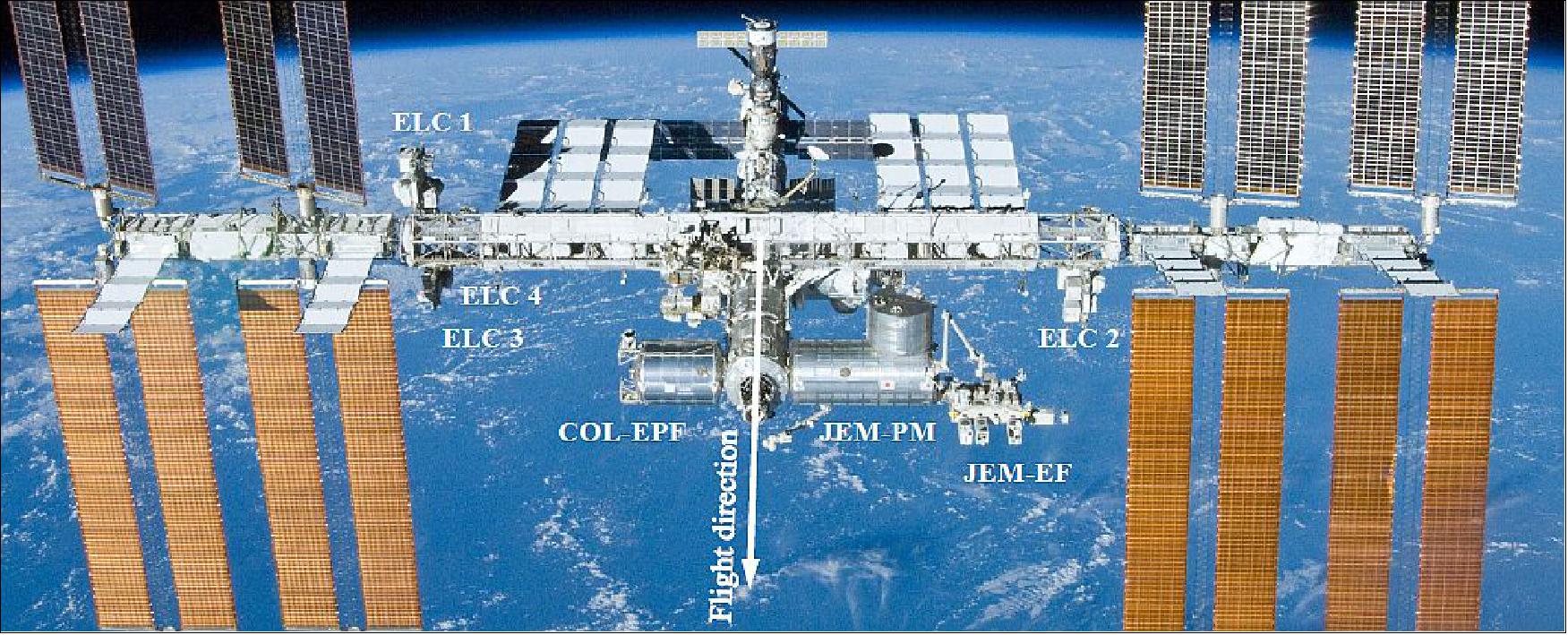
These external facilities are well booked for the coming years. To overcome this limitation Airbus DS has proposed to provide the new Bartolomeo external payload facility to the forward-facing position of the European Columbus module (Figure 2). The new system will extend the infrastructure and capability of the ISS by 12 additional external sites fitting the expectations of the market. Bartolomeo brings features to its users which are unique for external platforms:
• Unobstructed view of Earth and space
• Unpressurized and pressurized launch of payloads
• Payload or sample return option
• Active cooling capability
• Easy access through standardized payload interfaces
• Enhanced data downlink budget for its payloads.
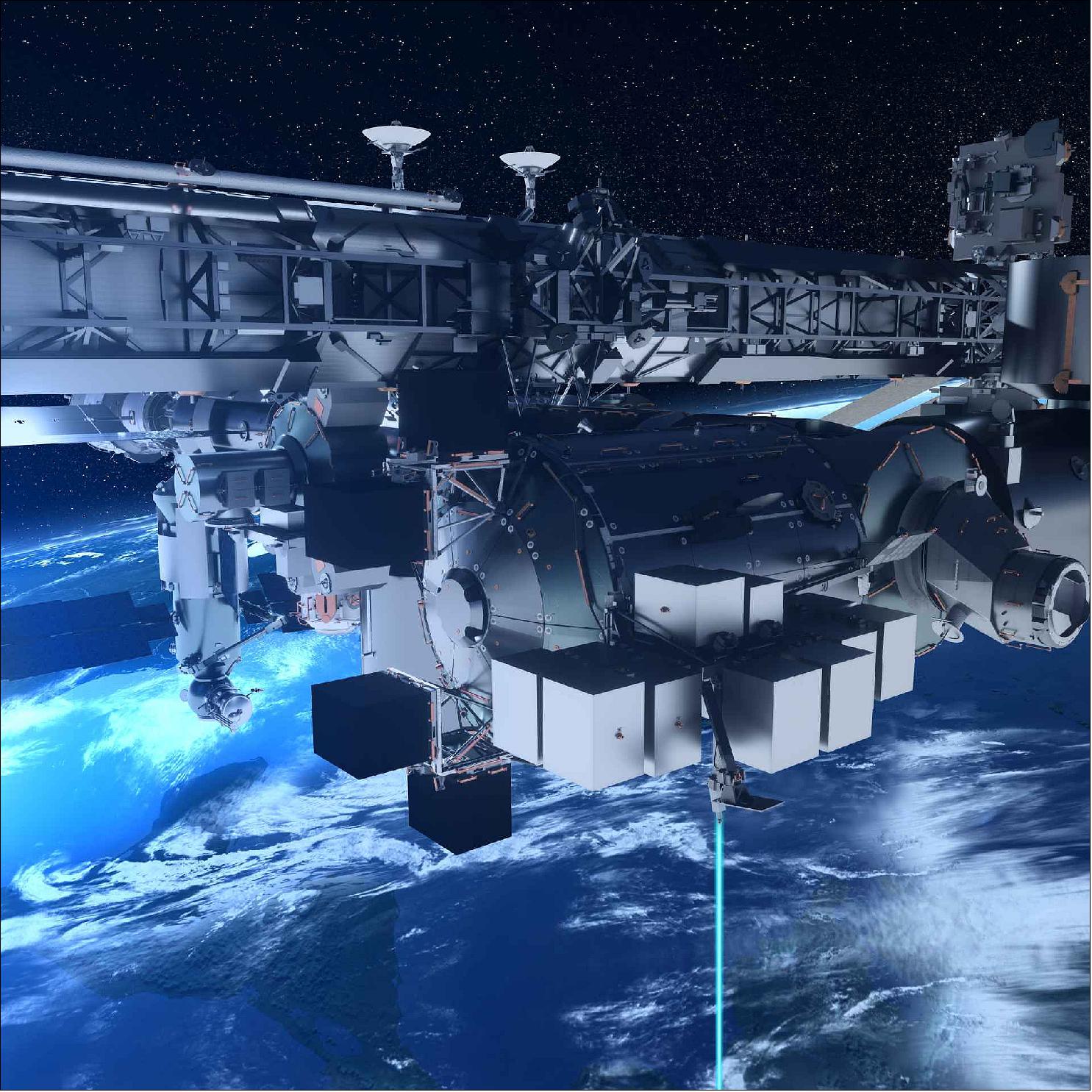
Legend to Figure 2: As of 2018, a laser communication link was added to the Bartolomeo platform (Ref. 15).
ESA (European Space Agency) and Airbus DS have signed a PPP (Public Private Partnership) agreement for the construction, launch and operations of the commercial "Bartolomeo" platform — Airbus' new external payload hosting facility will be attached to the European Columbus module of the ISS (International Space Station) from mid-2019. 6)
The signing of the commercial partnership will make Bartolomeo a reality next year. While the European company funds the development and promotes commercialization, ESA will support the launch, installation and operations.
Bartolomeo is planned to be operated in a commercial end-to-end mission service enabling fast, cost-efficient and reliable access to low Earth orbit for commercial as well as institutional customers from Europe, the US and the rest of the world throughout the life of the ISS. As competitive end-to-end solution the Bartolomeo service contributes to achieving the scientific and economic goals defined in ESA's Space Exploration Strategy, responds to NASA's demand for external payload hosting on ISS, and provides a most attractive mission solution to the commercial and institutional user community of low Earth orbit.
Bartolomeo Platform System
Operational Facility Configuration: The Bartolomeo pallet structure is designed to fit into the available volume of the SpaceX Dragon Trunk for launch and will be attached on orbit to the Columbus Module Starboard Forward Trunnion with two struts to the Port and Keel trunnions. The pallet size allows for the accommodation of 6 FRAM (Flight Releasable Attachment Mechanism) Standard Payloads. Two Standard FRAM payload interfaces are available on each of the Zenith and Nadir-facing sides. Two additional FRAM interfaces are accommodated by the FRAM Extension Kit. Due to the size constraints of the Space-X Dragon trunk the FRAM Extension Kit will be launched with but not attached to the Bartolomeo pallet. The FRAM Extension Kit will be installed to the pallet structure via EVA once on orbit in concert with the installation of Bartolomeo on the Columbus Module. In addition to the FRAM capability, the pallet perimeter provides enough space to accommodate 6 JCAP (JEM Camera, Light, Pan and Tilt Assembly Adapter Plate)-based payloads. The design of the Bartolomeo platform in its fully occupied configuration is shown in Figure 4 with and MUSES 7) tentatively installed in the forward Zenith-facing FRAM slot (FRAM-2). 8) 9)
All payload interfaces use the GOLD-2 (General-Purpose Oceaneering Latching Device-2) interface (Figure 3). Through the utilization of the ISS payload airlocks the Bartolomeo concept allows to return samples or entire payloads, depending on their size, back to Earth. The GOLD-2 payload interface allows to remove payloads from the platform using the ISS RMS and to put them into one of the ISS payload airlocks with appropriate counter interfaces. After having been transferred to the inside of station, samples are packed again into CTBs (Cargo Transportation Bags) for return. Payload or sample return is an optional service depending on the availability of slots in a returning vehicle. Nominally, payloads are removed from the platform at the end of the service contract and undergo destructive re- entry or return onboard a visiting vehicle.
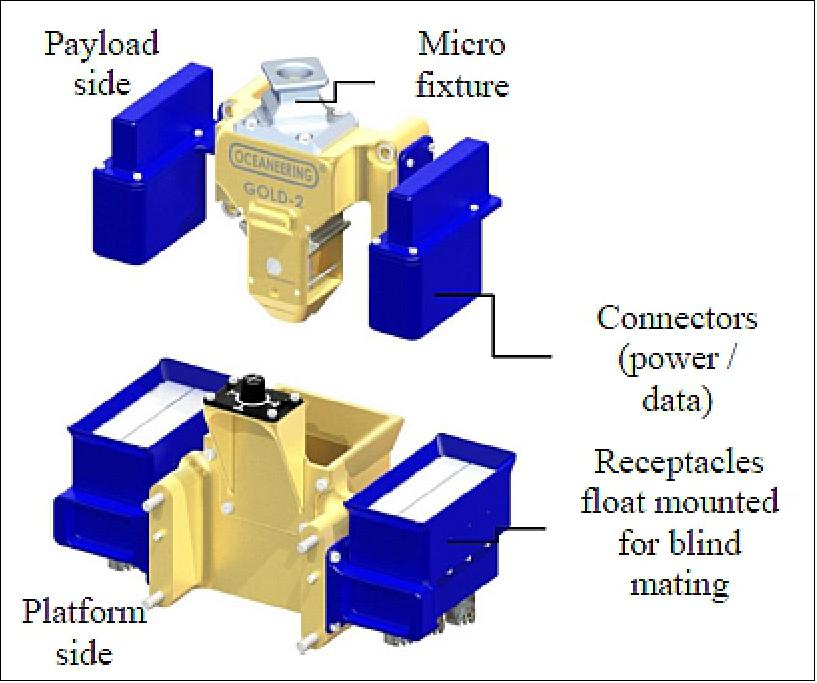
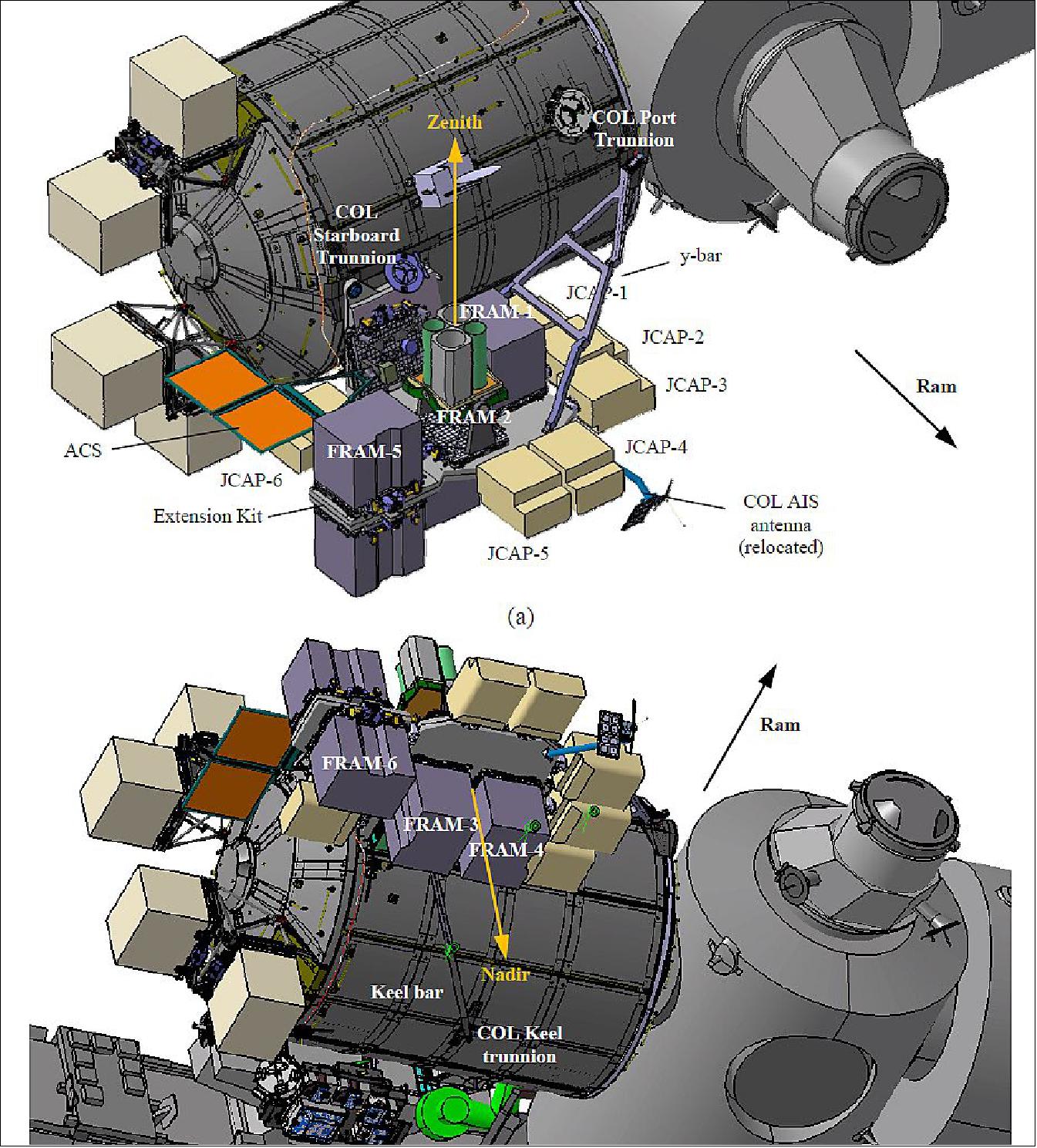
Power and Data Provision to Payloads: Bartolomeo provides an avionics system for power management, payload command and data routing, and control of the ACS (Figure 5). Power to Bartolomeo is received from COL via the PAPOS (Payload Parking Position Interface) interface at Columbus and from a dedicated NASA/USOS (United States Orbital Segment) - provided power line. All 6 FRAM-sites will nominally receive 120 VDC compatible with the ExPA (EXPRESS Pallet Adapter) as well as CEPA (Columbus Experiment Plate Assembly) standard via dedicated pin allocations in the power connectors. A total of 28 VDC to FRAM-sites can optionally be made available as required. For supplying the 6 JCAP-based payload slots, the 120 VDC power is converted to 28 VDC.
The Bartolomeo command and data routing provisions are connected to the Columbus data management system, which provides hardwired connections via the Columbus External Command & Measurement Unit. In addition it is intended to provide access to the ISS external wireless system, as well as to a Bartolomeo-provided wireless provision supporting Internet Packet based communication with end users.
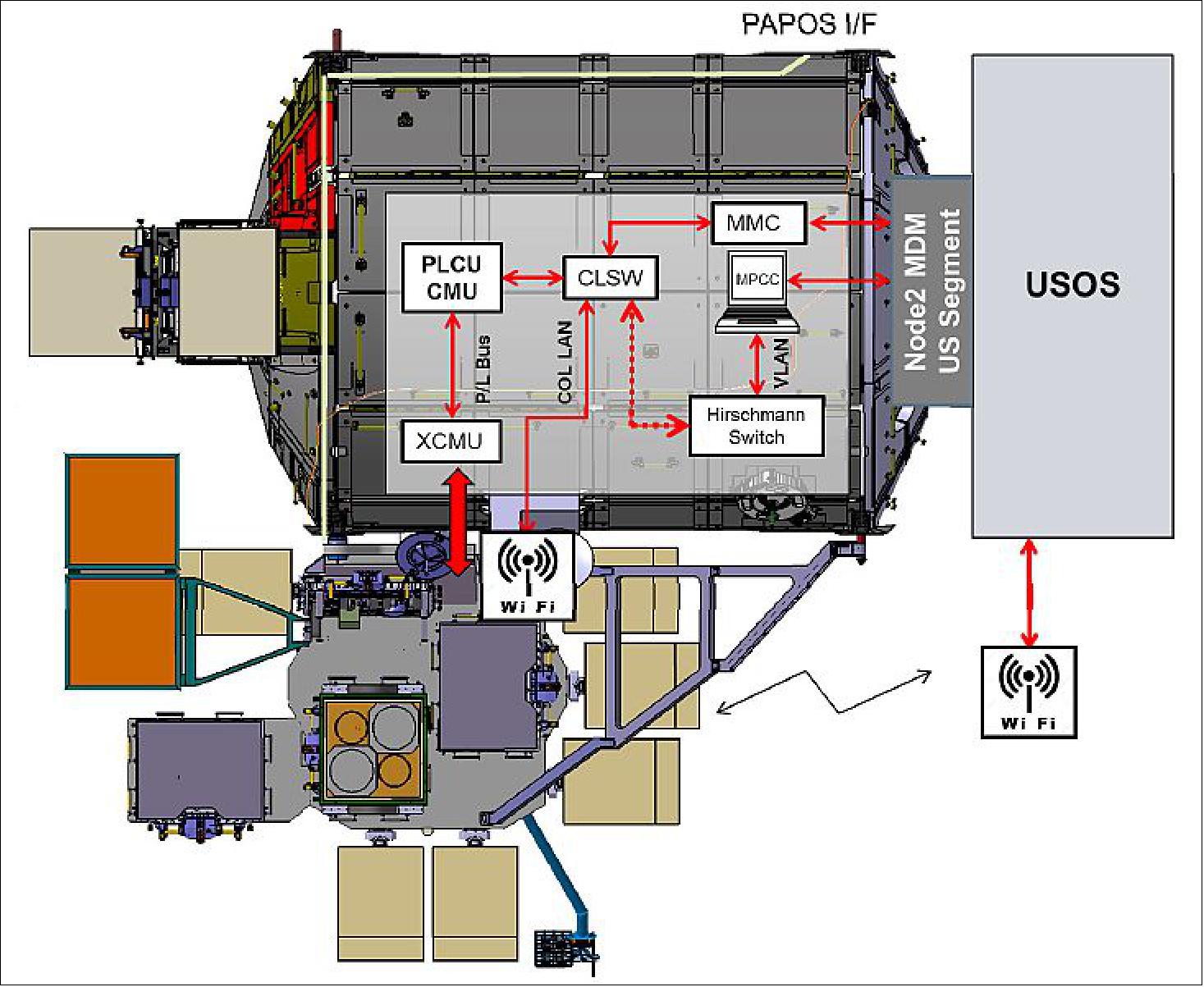
Payload Viewing Conditions: The position of the Bartolomeo platform on COL facing forward provides very good viewing conditions in the Zenith, Nadir and Forward direction, reduced viewing sideward and some limited viewing in the Wake direction. The results of a field of view analysis for representative payloads on the pallet are presented in Figure 6 for the Zenith-, Nadir-, Ram-, and Wake-oriented half spheres. In this stereographic projection the light red areas indicate the approximate temporary obscuration of the payload view towards space or Earth.

The total obscuration maxima and minima over one orbit are summarized in Table 1 for all viewing directions. This analysis does not consider visiting vehicles docked to Node 2.
Parameter | Zenith | Nadir | Ram | Port | Starboard |
Minima | 22.4% | 1.1% | 0% | 57.6% | 45.1% |
Maxima | 34.4% | 8.7% | 5.3% | 58.6% | 48.1% |
Bartolomeo Platform Servicing Concept
Platform Servicing Concept: During the utilization phase the Bartolomeo platform concept is fully robotically serviceable. All payloads will be installed using the ISS RMS (Robotic Manipulator System) only. Two different payload sizes are foreseen in the design, an airlock-compatible size suitable for pressurized transport using JCAP brackets as payload to platform interface, and the FRAM-based standard size for unpressurized transport. The payload slot features, interfaces, budgets and servicing concepts are summarized in Table 2.
Item | JCAP-based Payloads | FRAM Standard Payloads | |
Quantity of sites | 6 | 6 | |
Field of View | • All Nadir and Zenith view | • 2 slots Zenith and Ram view | • 1 slot Zenith, Ram, Starboard |
Geometric envelopes | 640 x 830 x 1000 mm 1) | 864 x 1168 x 1245 mm | 864 x 1168 x 1245 mm |
Mass per payload | up to 300 kg nominal | up to 599 kg nominal 3) | up to 300 kg nominal 3) |
Power per payload | up to 150 W | 120 VDC operational power up to 800 W, CEPA / ExPA compatible 3) | 120 VDC operational power, |
Data I/F to COL | up to 100 Mbit/s via | • up to 100 Mbit/s via | up to 100 Mbit/s via |
Cooling capability | None | 1 Nadir, 1 Zenith site cooled | None |
Servicing concept | • Pressurized upload | • Unpressurized upload | • Unpressurized upload |
Payload to platform interface | JCAP bracket and electrical | P-FRAM standard, P-FRAM | P-FRAM standard |
Legend to Table 2:
1) Geometric envelope constrained by JEM airlock dimensions, envelope can be extended if payload is launched unpressurized.
2) FRAM (Flight Releasable Attachment Mechanism) capability depends on payload center of gravity
3) Power routed from Columbus
4) Power routed from ISS US Segment
Pressurized Transport Opportunity: The launch of payloads to the ISS is a resource that is very well available for payloads transported in a pressurized environment among other resupply items required by the station operations. With the aim of providing a reliable and easy to prepare way of transportation to ISS, payloads may be launched pressurized to the station and are installed into the Bartolomeo platform using the JEM (Japanese Experiment Module) airlock. Due to the high frequency of flights and the flexibility of the vehicle manifests the risk of a delay in the payload readiness can be mitigated by delaying to the next flight opportunity which on average is available not more than two months later. The launch within the system of ISS resupply flights introduces an unparalleled reliability of the access to LEO (Low Earth Orbit) for small size payloads. The size of the payload items is limited by the envelope of the JEM airlock. This limitation, however, may be mitigated by the potential availability of the NanoRacks airlock in the near future.
Another attractive feature of the pressurized launch option is the relaxed vibrational environment experienced by the payload during launch, due to the transportation of payloads packed in foam inside the standardized Cargo Transfer Bags.
Payload or Sample Return Option: Through the utilization of the Japanese airlock the Bartolomeo concept allows to return samples or entire payloads, depending on their size, back to Earth. The JCAP payload interface allows to remove payloads from the platform using the ISS robotic manipulator system and to put them onto the extended Japanese airlock slide table which needs to be equipped with the available counter interface. After having been transferred to the inside of station, payloads are packed again for return.
Comparison with Existing External ISS Sites
The Bartolomeo system is very much competitive in comparison to the other existing external payload sites on the ISS:
• ELCs (Express Logistics Carriers) with FRAM payload slots
• JEM-EF (Japanese Experiment Module Exposed Facility)
• COL-EPF (Columbus External Payload Facility)
• NREP (NanoRacks External Platform) for very small size payloads
Bartolomeo offers a payload mass and volume capability similar to the ELCs and COL-EPF, whereas the JEM-EF offers much larger payload accommodation (Figure 7). Bartolomeo is very competitive regarding the viewing conditions and the power and data resources available. Bartolomeo payloads can use up to 800 W of power which the other platforms except JEM-EF are unable to provide. Bartolomeo will provide active cooling capability to its payloads as well as the option to choose between unpressurized and pressurized launch and to return samples or the entire payload back to Earth (Table 3)
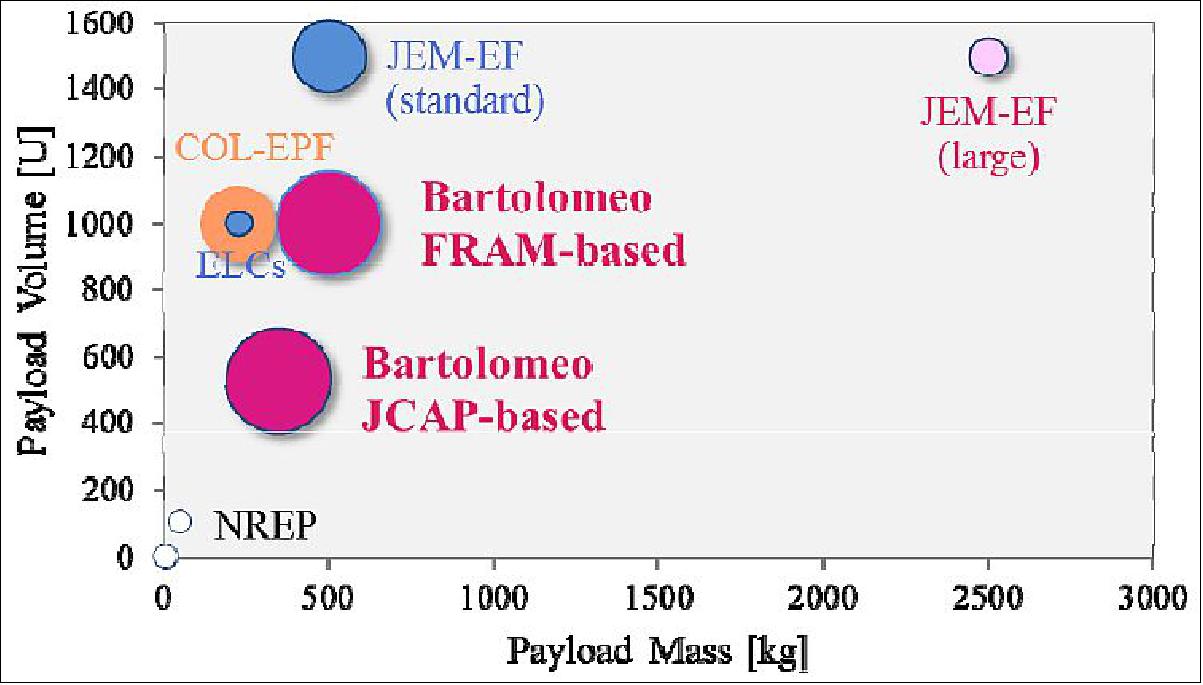
Sites | View | Size | Mass | Power | Data | Cooling | Launch | Return |
ELCs | Obstructed | 864 x 1168 x | up to | 750 W @ 120 VDC | 10 Mbit/s | No | Unpressurized | No |
COL-EPF | Good | 864 x 1168 x | 370 kg | TBD | 100 Mbit/s | No | Unpressurized | No |
JEM-EF | Obstructed | 800 x 1000 x | 500 – | 6 kW @ 120 VDC | 100 Mbit/s | 900 W per | Unpressurized | No |
NREP | Obstructed | 100 x 100 | 4 kg | 30 W @ 28 VDC | TBD Mbit/s | No | Unpressurized | Yes |
Bartolomeo | Very good | 640 x 830 x 1000 mm | up to | up to 100 W @ 28 | 100 Mbit/s | No | Pressurized/ | Yes |
Bartolomeo | Very good | 864 x 1168 x | 300–599 kg | 800 W @ 120 VDC | 100 Mbit/s | 1.5 kW for | Unpressurized | No |
In summary, the Bartolomeo platform will provide an end-to-end service that offers fast, cost-efficient and reliable access to the ISS for private and institutional users on commercial terms. Its all-in-one payload mission service will attract customers from areas including Earth observation, technology demonstrators, astro- and heliophysics, material science and new space flight applications.
Development Status
• March 4, 2020: Batolomeo's days on Earth are numbered - the external platform Bartolomeo is currently waiting for its launch to the International Space Station (ISS) at Kennedy Space Center in Florida inside a SpaceX Dragon capsule. "With the 'research balcony' Bartolomeo, the ISS is entering a new era," says Walther Pelzer, Member of the German Aerospace Center (Deutsches Zentrum fur Luft- und Raumfahrt; DLR) Executive Board and head of DLR Space Administration. 10) 11)
- "This project 'made in Germany' is making a significant contribution to the commercialization of the ISS. Bartolomeo is Europe's first private external platform on the ISS and offers companies and research institutions the unique opportunity to develop their project quickly and easily in space." Following extensive vibration tests at the DLR Institute of Aeroelasticity in Göttingen, and successful final tests in Florida, SpaceX-20 is now set for launch on 6 March 2020. The platform was built by Airbus in Bremen and will be operated jointly with the Columbus Control Center at DLR's site in Oberpfaffenhofen.
An External Laboratory to Expand the ISS
- Bartolomeo is the first commercial platform on the exterior of the Columbus module of the ISS. The Canadian robotic arm will first move the platform to its destination and attach it there. Two astronauts will then carry out the electrical installation during an extravehicular activity. With its dimensions of two by two and a half meters and a mass of 484 kg, the new platform will extend the available space on the ISS by adding a kind of research balcony with 12 payload slots and three antenna positions. The payloads can be around half a cubic meter in size and have an unobstructed view of Earth or space from an altitude of ~ 400 km. Bartolomeo is therefore particularly suitable for experiments that require an open space environment.
A Wide Range of Possible Uses
- "Radiation biologists, solar physicists and astrophysicists, Earth observers and atmospheric and climate researchers will all benefit from the new platform," says Julianna Schmitz, who is responsible for ISS commercialization at the DLR Space Administration. "Bartolomeo is particularly suitable for technology testing and validation. There are unique possibilities here that cannot be achieved in any laboratory on Earth because optical sensors, materials, robotic components and antennas can be tested directly in the space environment." For example, the OSIRIS laser communications terminal of the DLR Institute of Communications and Navigation in Oberpfaffenhofen is also expected to be located on Bartolomeo from 2021. The system was developed in cooperation with the industrial partner TESAT in Backnang, near Stuttgart, and is intended to transmit the constantly growing volume of data from experiments on the ISS quickly and securely down to Earth. In addition to the advantage of testing experiments and technologies directly in space, it is also considerably more cost-effective to conduct these experiments on Bartolomeo than it would be on satellites. They do not require their own rocket launch but rather are accommodated on routine supply flights to the ISS. "This simple and cost-effective operation makes Bartolomeo particularly attractive for small and medium-sized enterprises (SMEs) and can open up new business opportunities for them, for example in the field of telecommunications," explains Schmitz. "No astronauts will need to be deployed to retrofit Bartolomeo with scientific payloads. Thanks to the payloads' standardized dimensions and interfaces, installation is much easier and can be carried out purely robotically via remote control from Earth." A robotic arm on board the ISS picks up the module at one of the two experiment airlocks and installs it at its location on Bartolomeo.
Tickets for Commercial ISS Use
- Bartolomeo is intended to give commercially motivated experiments quick and simplified access to the ISS. To this end, Airbus, as the manufacturer of Bartolomeo, also sells these flight opportunities to research and industrial organizations. According to Airbus, the annual rent will range between 300,000 to 3.5 million euro depending on the size of the payload. This includes user support for experiment development and safety certification, the flight to the ISS, installation via the robotic arm, experiment operation and finally, data handling. In doing so, Airbus is not only a contractor. The company has invested 40 million euro of its own financial resources in the development, construction and operation of Bartolomeo and has developed the platform in cooperation with the European Space Agency (ESA). Among the ESA member states, Germany is the largest stakeholder in the ISS program.
Outlook
- Bartolomeo was born from ESA's call for ideas on the commercial exploitation of the ISS and is now the second partnership of its kind. The first was the ICE Cubes system for small, standardized payload containers from the Belgian company SAS, which Alexander Gerst installed in the Columbus laboratory during the horizons mission. Further commercial partnerships have already been agreed. ESA reserves 30 percent of its ISS resources for national programs and commercial services. These are the first steps towards a commercialized use of the ISS and are in line with the commercialization strategies of its international partners. They should further boost the development of commercial offerings on the ISS and in low Earth orbit and open up their research opportunities to other user groups. In the long term, space agencies hope that this will provide access to the ISS at a lower cost than would be the case if it were operated purely by public institutions.
• February 7, 2020: Airbus workers unpack the Bartolomeo platform in the Space Station Processing Facility high bay at NASA's Kennedy Space Center in Florida on Jan. 30, 2020. Bartolomeo was manufactured by Airbus Defence and Space. The platform will be delivered to the International Space Station aboard SpaceX's 20th Commercial Resupply Services (CRS-20) mission for the agency. 12)
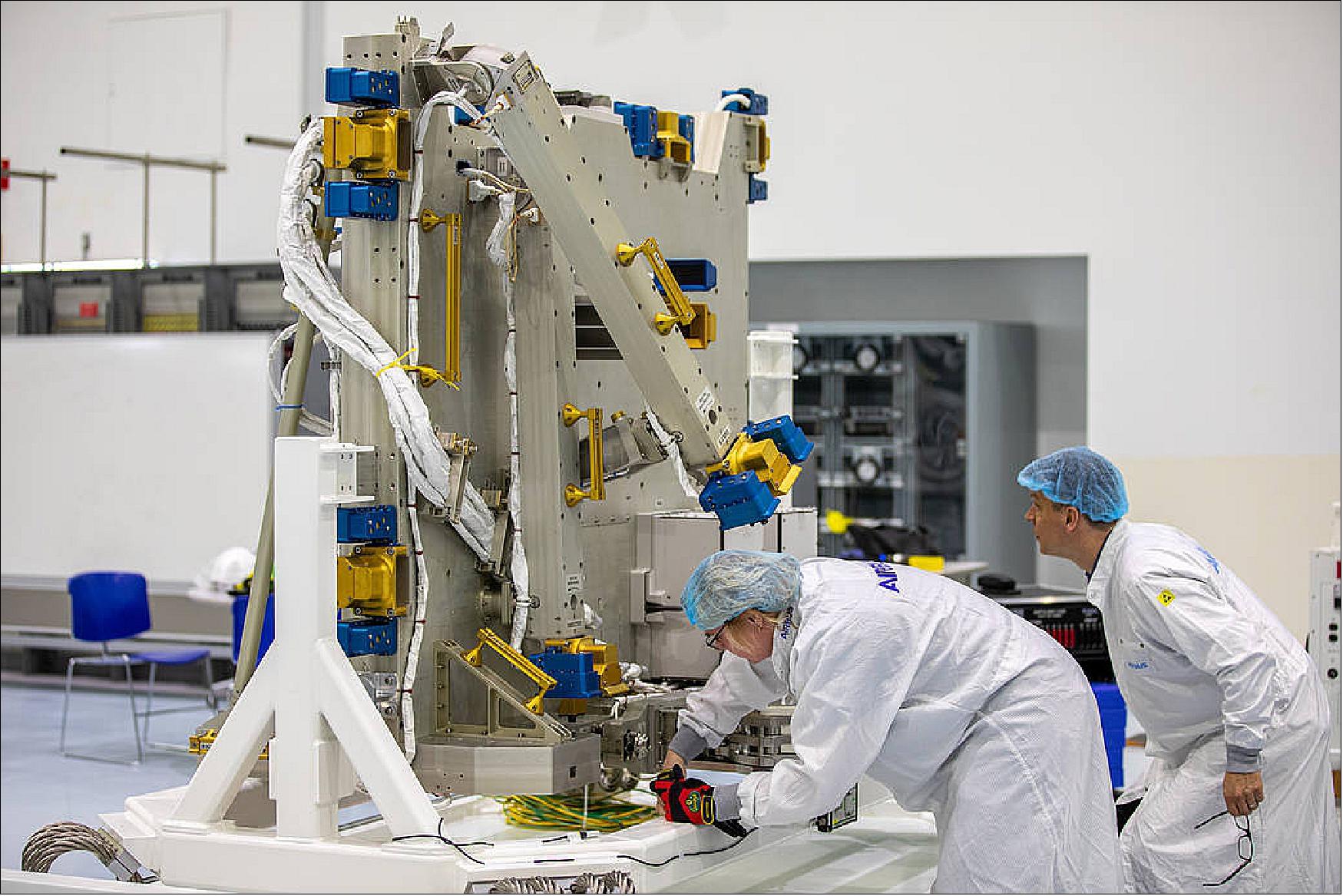
• October 23, 2019: Quick access to space and high-speed data transfer are paving the way for competitive science on the International Space Station. The Bartolomeo external platform received a boost today as ESA and Airbus confirmed their interest in using this new space-based vantage point for several experiments. 13)
- The Bartolomeo service will provide end-to-end access for external payloads on the Station. A new community of start-ups and space entrepreneurs will benefit from an unobstructed view of Earth, direct control of experiments from the ground and the possibility of retrieving samples.
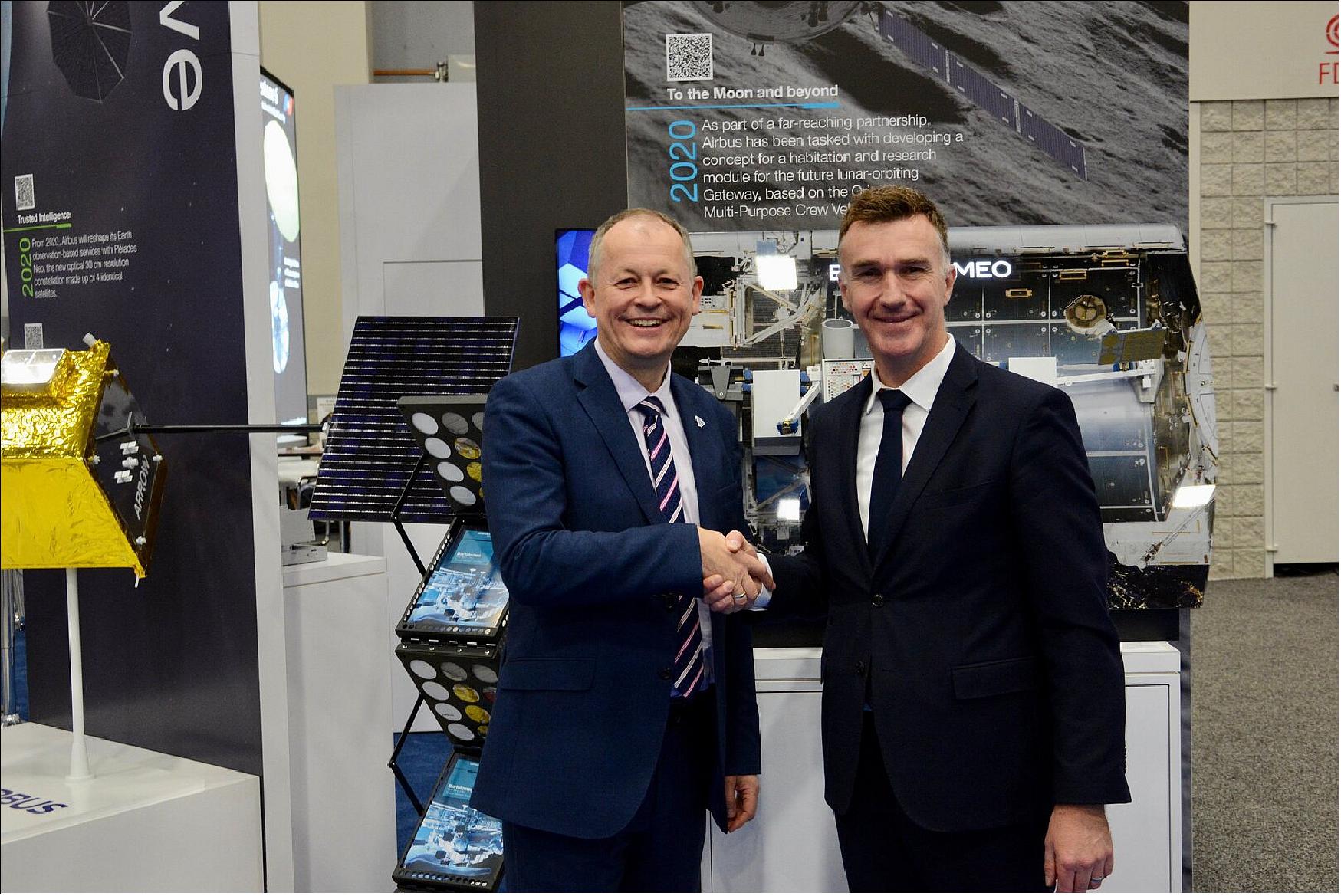
- The International Space Station has hosted around 370 European experiments over the last two decades. However, the demand for experiment slots far outstrips supply.
- "Bartolomeo offers an attractive and competitive space platform for new users looking to reduce costs and shorten turnaround times," said David Parker, ESA's Director of Human and Robotic Exploration, while signing a statement of intent at the 70th annual International Astronautical Congress.
- Commercialization is part of our vision to secure the continued presence of humans on the Space Station and beyond. This innovative, cost-effective approach is key for missions to the Moon and Mars," he added.
- In a press statement, Airbus acknowledged it is "excited about the evolving interest of European customers," following the signature of a partnership agreement with ESA last year.
The Science Must Go On
- The first experiment to find its science spot will be the Multi-Needle Langmuir Probe, a payload made in Norway to control the electric potential of a spacecraft or satellite platform with an electron emitter.
- New experiments such as ESA's exobiology facility are increasing the Station's capabilities for investigating the study of life in space.
- One of the main instruments to do this is an ultraviolet-visible spectrometer. Its technology was set to run for 75 days in the Station's internal ICE Cubes facility to help refine the final product.
- Another experiment planned for Bartolomeo is being developed by France's space agency CNES to investigate the ageing of new materials during spaceflight.
• December 6, 2018: UNOOSA (United Nations Office for Outer Space Affairs) is partnering with Airbus Defence and Space GmbH to offer United Nations Member States the opportunity to accommodate a payload on the Airbus Bartolomeo external platform on the International Space Station. The mission will be open to all Member States of the United Nations, and developing countries are particularly encouraged to participate. The platform will accommodate and operate payloads provided by institutions in the participating countries. 14)
- The purpose of this Call for Interest (CFI) is to provide a summary of the proposed mission opportunity and to solicit information from Member States' entities interested in providing payloads that could be flown on this mission. The CFI also has the objective of gathering information on the interested countries so that UNOOSA may better understand the demand for this type of mission. This mission is devoted to addressing the Sustainable Development Goals (SDGs).
- The mission of UNOOSA is to promote international cooperation in the use of outer space to achieve development goals for the benefit of humankind. There is no better example of UNOOSA's vision ‘to bring the benefits of space to humankind' by showing space's importance in the realization and implementation of the 17 Sustainable Development Goals shown in Figure 11.
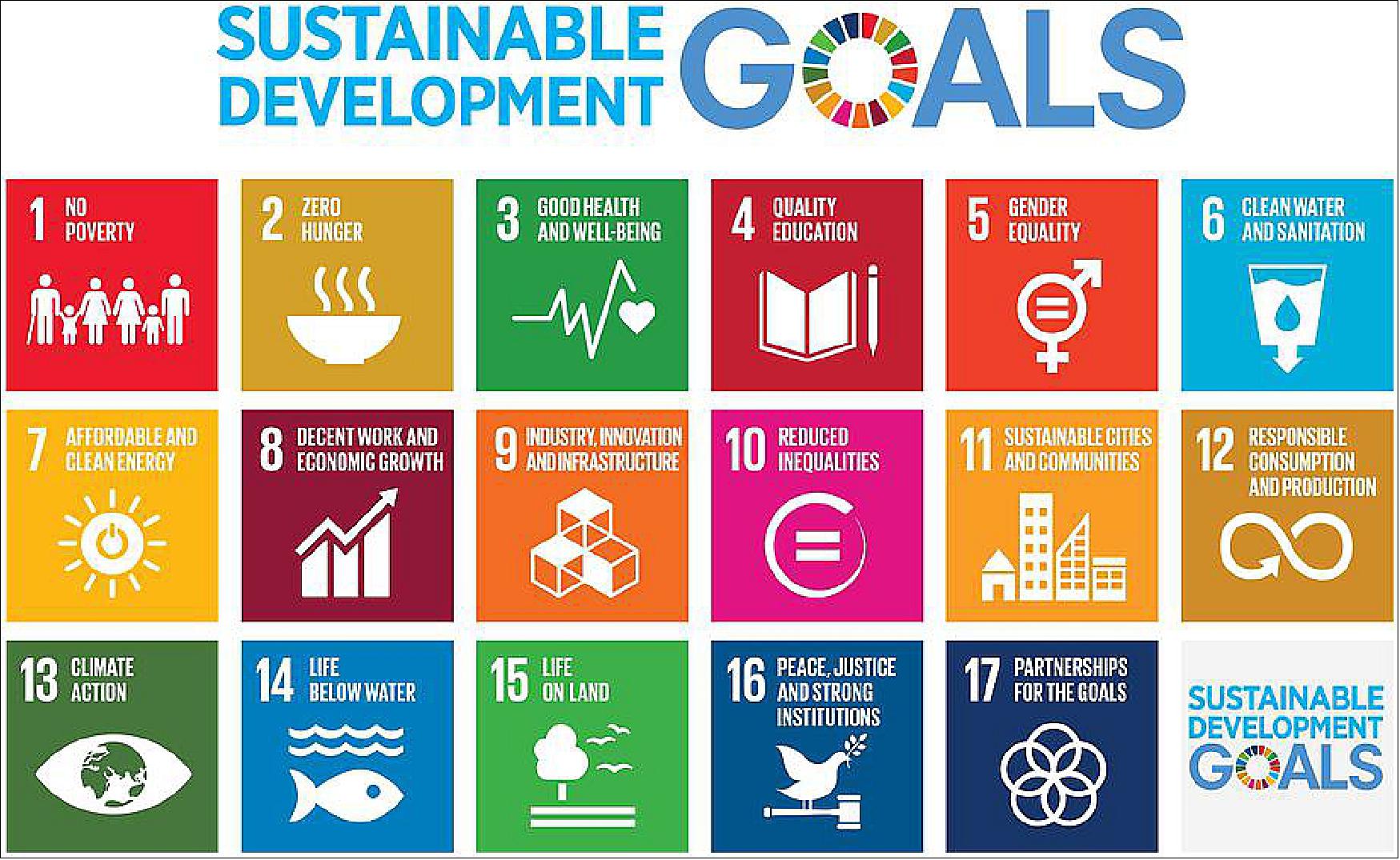
• March 26, 2018: The first high capacity space-to-ground laser communication system is to be installed on the Bartolomeo platform of the ISS as part of a collaboration between Airbus Defence and Space, the Institute of Communications and Navigation of DLR (German Aerospace Center) and Tesat-Spacecom GmbH & Co. KG. The system, called OSIRIS, will provide DTE (Direct To Earth) technology with a data rate of 10 Gbit/s over a range of about 1,500 km (Figure 2). 15)
- Small in seize and mass, OSIRIS will directly link to several ground stations providing unparalleled data downlink capacity to Bartolomeo and its experimental payloads. The goal is to make OSIRIS an operational system embedded in the ISS infrastructure. This new European capability will enhance the utilization opportunities on the European Columbus module and make Bartolomeo the go-to platform for data-intensive payloads on the ISS.
- "Laser communications using Bartolomeo will pave the way for digitization of ISS operations enabling direct access to huge volumes of data to benefit customers," said Oliver Juckenhöfel of Airbus.
- The platform hardware is in development at Airbus' Bremen site and is currently undergoing a design review with the ESA and NASA. Bartolomeo will be operated by Airbus and attached to the outside of the Columbus European module ready for commercial operations from 2019.
- DLR and Tesat-Spacecom have entered into a long-term cooperation regarding research, development and industrialization of systems for optical space-to-ground links.
- DLR's novel design, optimized for high performance, small size and low complexity, combined with Tesat's long-term in orbit experience of laser communications, have resulted in OSIRIS having very high data rates and an affordable price point.
• February 7, 2018: The platform development has recently passed the PDR (Preliminary Design Review) and is on track for launch in May 2019. First payloads are then expected to be installed in the second half of 2019. Key to offering a service for smaller payloads is the General-purpose Oceaneering Latching Device (GOLD) — a new attachment mechanism for payloads of up to 125 kg. and 0.5 m3 developed by Airbus' partner Oceaneering Space Systems in Houston, Texas. The two companies are also working on the system to attach the platform to the Columbus module using ISS robotics. 16)
- Oliver Juckenhöfel, Head of On-Orbit Services and Exploration at Airbus, reported that the company's role is to make access to LEO as easy as it possibly can be and open up the ISS to a global user community. The company is creating a cost and time efficient way for institutional and private organizations to bring their experiments into space as external payloads that can be launched just 18 months after signing a contract. With Airbus' All-in-One Space Mission Service, Bartolomeo users can concentrate on their payload, while everything else is taken care of, from launch and installation, to in-space operations, communication links and even all the way to returning the experiment to Earth, if it is required.
Launch
The Bartolomeo platform was launched to the ISS on 7 March 2020 (04:50:30 UTC) on a Space-X-20 Dragon Falcon-9 Block 5 vehicle from Cape Canaveral SLC-40 (Space Launch Complex-40). The platform will be installed on the COL-EPF (Columbus Laboratory Module Exposed Payload Facility) of the ISS external facility. 17)
Orbit: Near circular orbit, altitude of ~ 400 km, inclination = 51.6º.
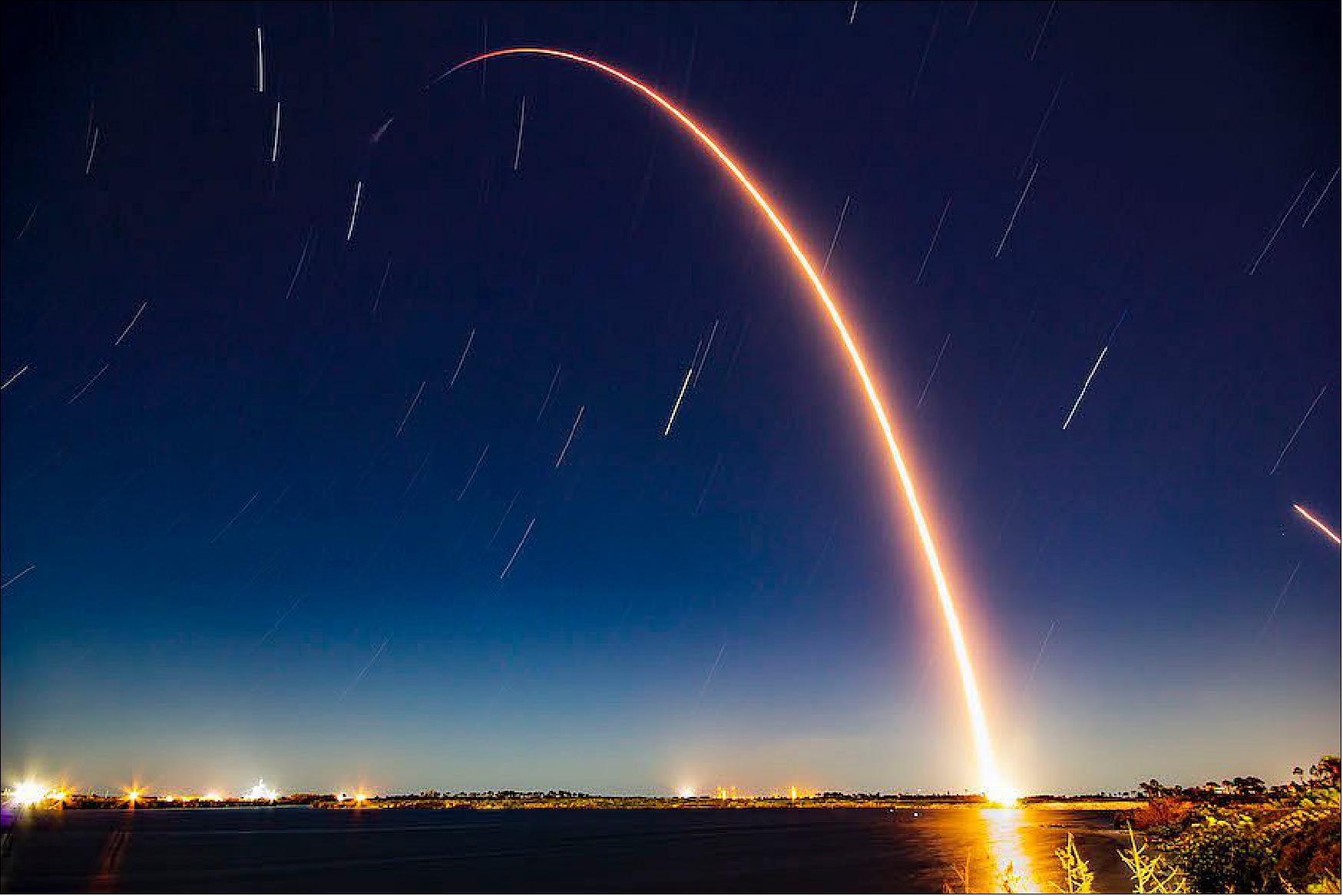
First customer: In September 2016, Neumann Space, an Australian Space technology company, and Airbus DS signed an agreement for a hosted payload aboard the new Bartolomeo platform of the ISS (International Space Station).
Named after the younger brother of Christopher Columbus, the Bartolomeo platform will be attached to the European Columbus Module and operated by Airbus DS starting in 2018. With its All-in-One Mission Service, Airbus DS provides all mission-related elements and can even assist when it comes to building the actual payload. 18)
Neumann Space will use their 50+ liters of payload space on Bartolomeo for their FAST (Facility for Australian Space Testing) program. Patrick Neumann, Chief Scientist and co-founder of Neumann Space stated, "The FAST program provides a unique opportunity for the in-orbit demonstration of technology for small and medium enterprises, schools and universities filling a gap in the current market. With FAST, a collection of payloads starting at just 1 kg mass will be sent together with our Neumann Drive to be operated in space for up to 12 months. We are glad to rely on Airbus Defence and Space to handle launch, power, in-orbit installation, communications down from the ISS and all the other bits and pieces needed to make this program a success."
Mission Status
• April 27, 2023: The International Space Station (ISS) partners have agreed to extend the operational period of the ISS. The United States, Japan, Canada and participant European Space Agency (ESA) countries will support operations until 2030, while Russia has committed to continuing station operations until 2028. 24)
• March 25, 2021: Space leaves its mark on materials: exposure to such a harsh environment can darken, crack or crater their surfaces – or even erode them away entirely. The nothingness of hard vacuum can also provoke ‘outgassing' vapors from materials that might degrade delicate mission systems. Accordingly ESA and the French space agency CNES are giving European researchers the chance to pit the latest aerospace materials directly against space. 19)
- "In-flight degradation can result in oxidation due to atomic oxygen – caused by standard oxygen molecules being broken apart by solar radiation, becoming very reactive single atoms of oxygen – or darkening from UV radiation," explains Sebastien Vincent-Bonnieu of ESA's SciSpacE team.
- "In addition coatings can crack due to the extreme temperature shifts encountered in orbit, embrittlement can be triggered by radiation, while impacts from space debris or micro-meteoroids can create small craters."
- A total of 15 different materials will be exposed directly to space on the Euro Materials Ageing Experiment, part of the Bartolomeo ‘front porch' attached to Europe's Columbus module aboard the International Space Station. The materials were selected following an ESA-CNES announcement of opportunity for European researchers.
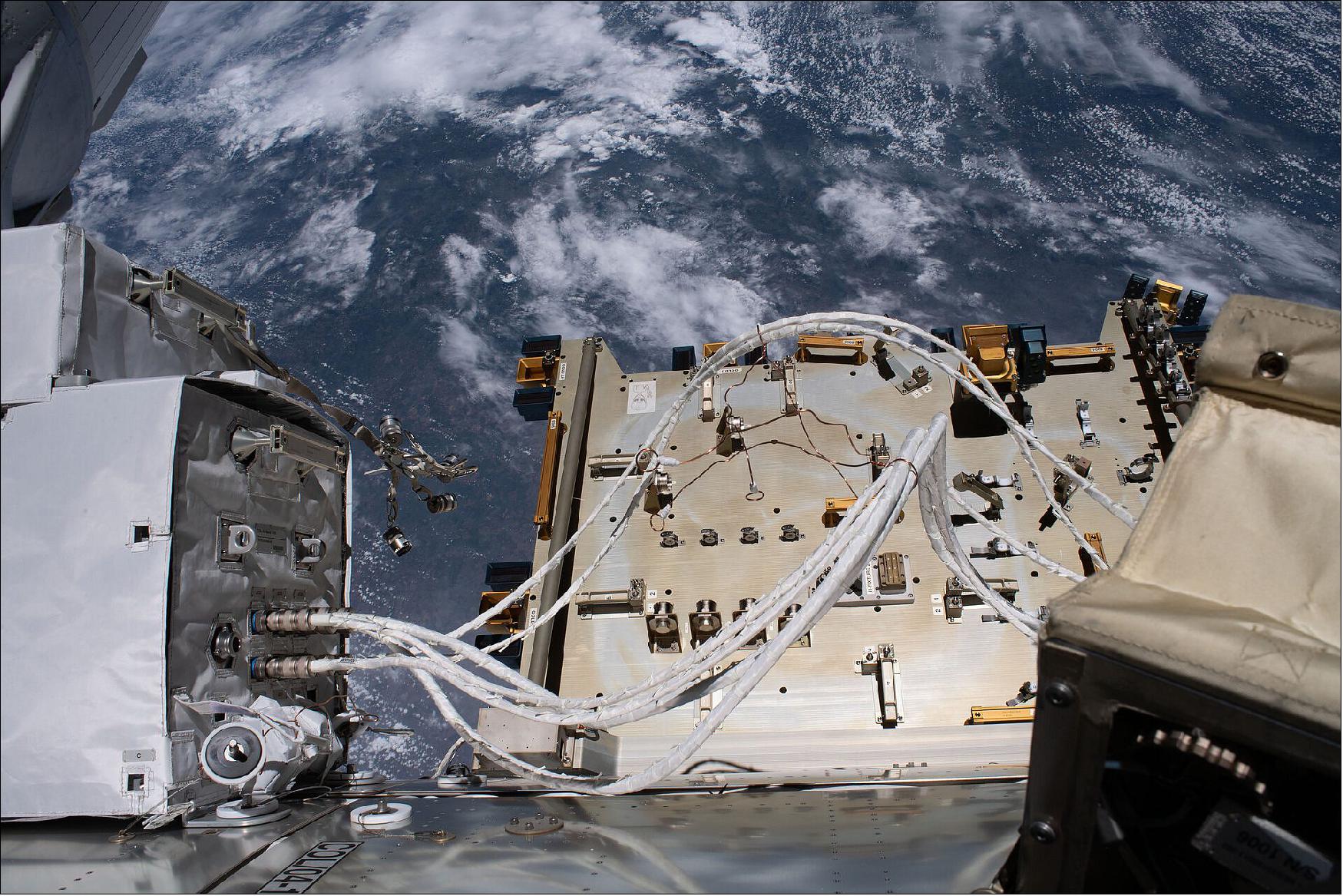
- "A wide variety of materials will be tested, including polymers with atomic oxygen protection coatings, 3D printed metals and plastics and new carbon fibre reinforced composites," adds Sebastien.
- "We will also fly our own materials to characterize their response to the space environment and provide reference data for experimenters," explains Adrian Tighe, Materials Engineer in ESA's Materials' Physics and Chemistry Section. "For example we will fly Kapton foils to measure atomic oxygen fluence, a novel UV sensitive material to measure solar radiation and clean glass surfaces to measure in-orbit contamination.
- "We will also fly a ceramic white coating, similar to that flown on BepiColombo, so we can directly study how it behaves in space. While it is not possible to get the materials back from a spacecraft cruising toward Mercury, it is possible to get them back from the ISS for detailed analysis back on Earth!"
- All the materials will undergo detailed pre-flight examination and characterization, using a suite of advanced surface analysis equipment and techniques. This will be performed by ESA's Materials' Physics and Chemistry Section, in the Materials and Electrical Components Laboratory, which is based in the ESTEC technical centre in the Netherlands.
- The team will for instance look at the materials' surface structure and chemical composition using scanning electron microscopes, x-ray photoelectron spectroscopy, atomic force microscopy – using a nano-scale stylus that ‘feels' individual atoms – plus laser-based ‘Raman' spectroscopy and 3D laser confocal microscopy.
- Riccardo Rampini, head of the Materials' Physics and Chemistry Section, explains: "It is important to characterize the materials before flight to be able to assess the in-flight degradation. We will also keep samples of the materials on-ground and monitor them regularly to check that there is no ground based degradation."
- Some materials could erode completely in orbit, so they are checked first in ground-based environmental test facilities, such as ESTEC's LEOX atomic oxygen facility. This is also very useful to compare ground-based and flight data, helping to update our prediction models about how materials behave in the space environment. Vibration testing is also required to make sure the samples will survive the violence of their flight to orbit.
- "All this analysis is performed only on reference samples, rather than the flight items," notes Adrian. "These flight samples need to be handled extremely carefully to minimize contact and prevent contamination before flight," notes Adrian."Even trace contamination can cause degradation when exposed to intense UV in orbit – so any fingerprints would be clearly revealed, for instance.
- "The flight samples will therefore be integrated into their holders very carefully, in full cleanroom conditions, and carefully checked using inspection lamps. Once all the samples are mounted they will be passed to CNES for integration onto the EMA payload."
- The detailed testing will subsequently be repeated when the samples are returned to Earth again – a relatively rare opportunity for the Materials' Physics and Chemistry section team.
- Riccardo says: "We did receive materials back from space from our Materials Exposure and Degradation Experiment (MEDET) – which we developed in conjunction with CNES and the French aerospace lab ONERA – as well as materials from the Long Duration Exposure Facility and the solar arrays of the Hubble Space Telescope – and we really learned a lot from the post-flight characterization and analysis.
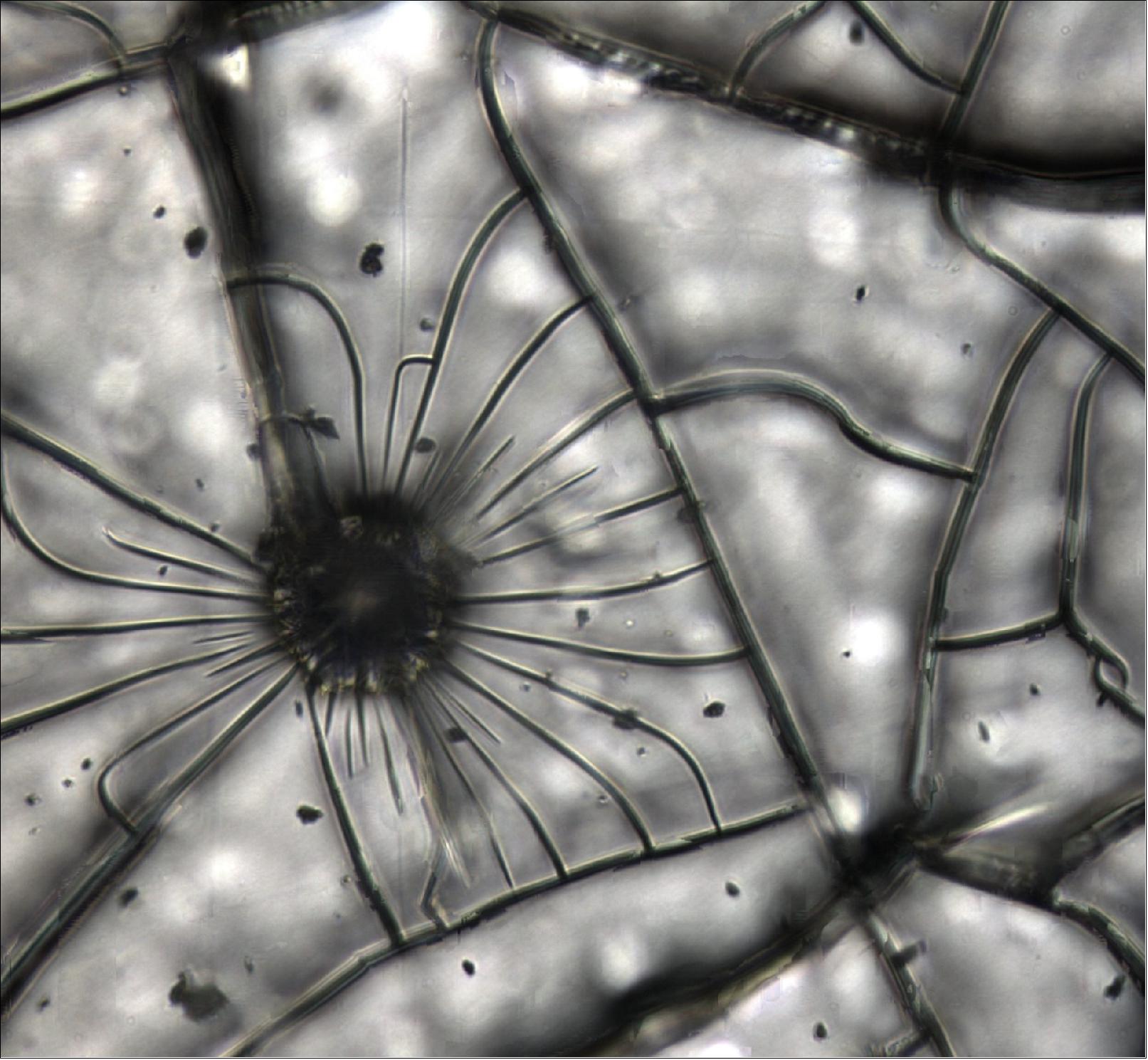
• June 4, 2020: Exposure to space can be bad for the health of many materials. ESA and French space agency CNES are offering European researchers the chance to study the harmful effects of space directly, by flying material samples on Bartolomeo, Europe's new ‘front porch' aboard the International Space Station. 20)
- A new joint CNES/ESA Announcement of Opportunity invites European material scientists, experimenters and engineers to test materials for space applications directly in the low-Earth orbit environment through use of Bartolomeo's ‘Euro Material Ageing' facility.
- To get a better understanding about how material ages beyond Earth's atmosphere, up to 45 samples are set to spend a minimum of six months exposed to the harsh space environment. Clamped between two aluminum plates, 20 mm of their exposed surface will cope with radiation, vacuum, temperature extremes and even space debris.
- This pilot project is targeting new or inexperienced players in the space business, with a focus on small-medium enterprises, academia or national institutes. ESA will cover the cost of flight, sample integration and pre- and post-flight sample analysis.
- The EMA (Euro Material Ageing) payload is also a great opportunity for our section's research fellows to get experience working with real spaceflight hardware and to learn how a space project works, especially working to a strict launch deadline, as well as with the universities and small companies putting forward the samples."
- The overall EMA payload is scheduled to fly to the ISS in 2022.
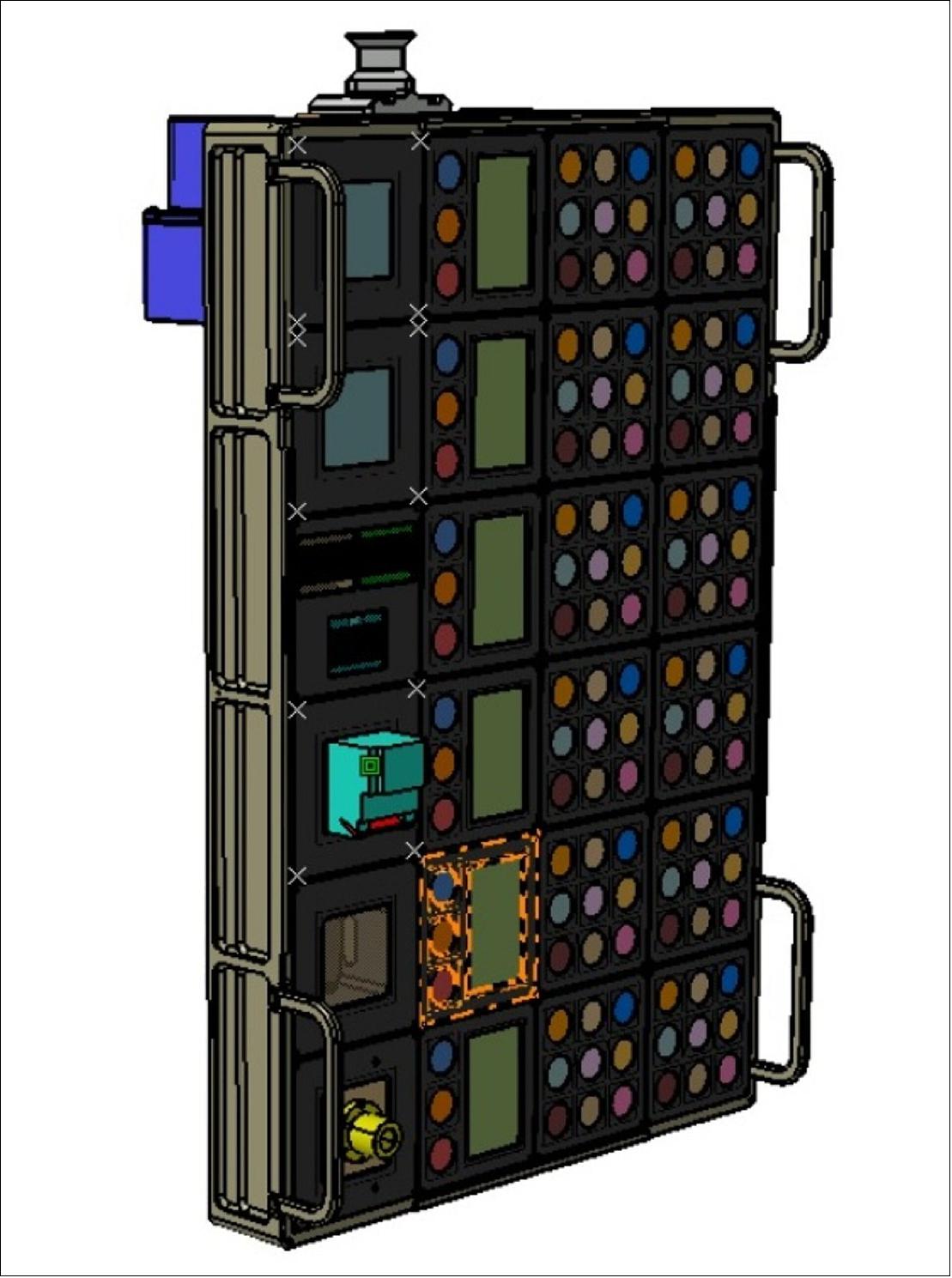
Material Challenges of Nothingness
- Space is an environment like nothing on Earth. Since the early years of the space age it has been clear that prolonged exposure to the vacuum of space results in material degradation – most notably in the case of plastics, but no substance is entirely immune.
- Although ESA has plenty of experience in exposing biology samples to space, "this is the first time ESA will display inorganic materials on a platform outside the International Space Station," explains ESA team leader for research Jennifer Ngo-Ahn.
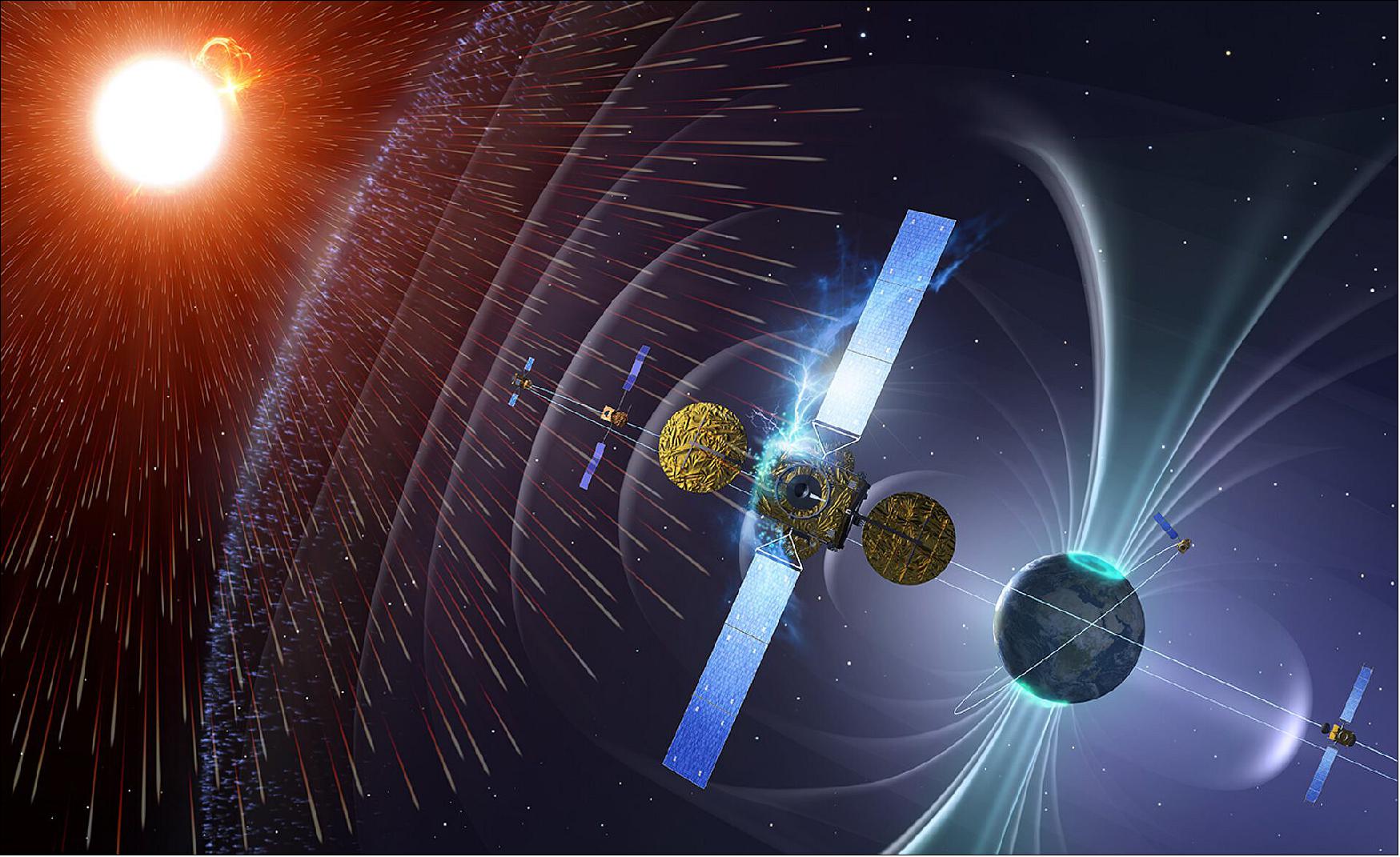
- The physical and chemical changes triggered by space exposure include discoloration, cracking and embrittlement, driven by particle and UV radiation exposure. Persistent exposure to nothingness leads to ‘outgassing' – the gradual boiling away of chemicals and solvents embedded within materials, which then risks contamination of sensitive satellite surfaces, such as instrument lenses.
- Materials sitting in the solar wind can build up a static charge which in the worst case can lead to electrostatic discharge – a form of ‘space lightning' implicated in the past loss of satellite functionality, even entire missions.
- And the frequent passing from sunlight to shadow experienced in low-Earth orbit causes extreme temperature shifts known as ‘thermal cycling'. Ongoing sudden shifts in temperature from up to 150 degrees C in sunlight down to -150 degrees C in the shade may cause cracking, misalignment, even buckling.
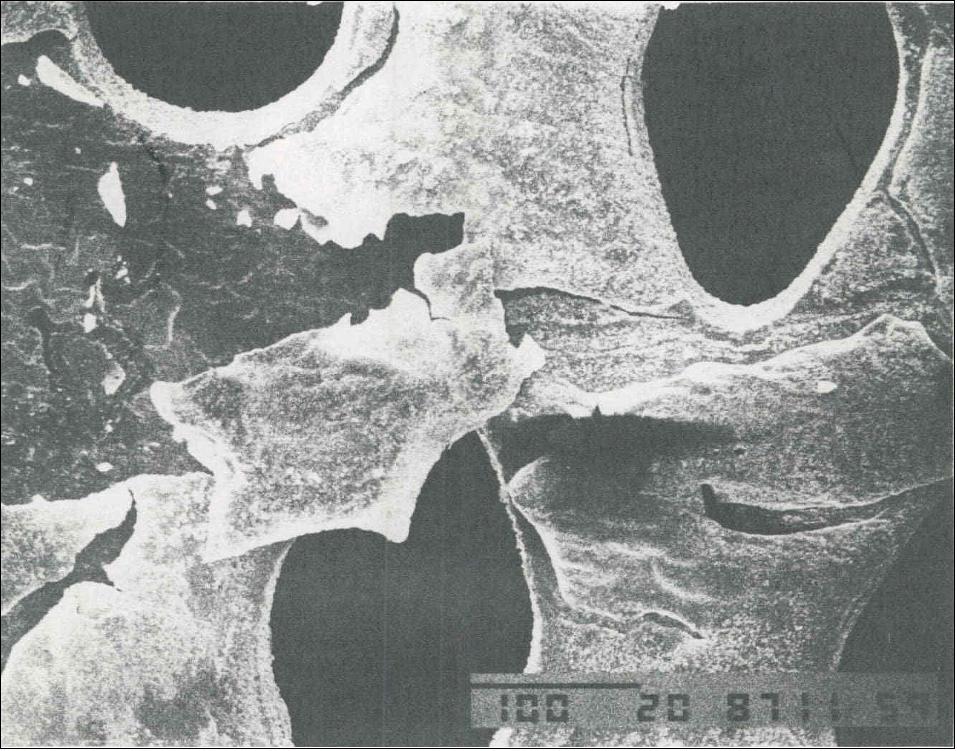
- Additionally, in the low-Earth orbit of the International Space Station, materials are exposed to a variety of oxygen normally encountered only in space – and known to eat away at satellite surfaces. This highly reactive ‘atomic oxygen' is formed from individual atoms of oxygen at the topmost fringes of the atmosphere, the result of standard oxygen molecules of the kind found just above the ground being broken apart by powerful ultraviolet radiation from the Sun.
- Bartolomeo's Euro Material Ageing facility offers a unique opportunity to expose test materials to the combination of these effects for real, comparing the results to equivalent samples on the ground, building up knowledge of material ageing in space.
- The benefits don't stop in space – research using this platform has potential of advancing innovation on Earth. "We could inform the design of fire-retardant and rust-resistant materials, and better protection for satellites could in turn help improve plastic siding for your house," points out Jennifer.
Announcement of Opportunity
- This new Announcement of Opportunity is a way to overcome these issues. Interested teams from ESA Member States or associated Member States can attend an online workshop and Q&A session on 11 June, with submission deadline of 17 July 2020.
• May 5, 2020: Airbus and Xenesis, a Chicago laser communications startup, have signed a contract for a payload slot on the International Space Station (ISS) Bartolomeo platform for the demonstration of their Xen-Hub optical communication space terminal. 21)
- The Xen-Hub is a greater than 10 GB/s optical communications terminal. The terminal was enabled with a technology transfer from the NASA/JPL (Jet Propulsion Laboratory) and is designed to increase satellite communications bandwidth.
- The Airbus-built Bartolomeo platform offers external science and payload hosting capabilities on the ISS, providing new opportunities for science and research. The platform, launched from the Kennedy Space Center in Florida, was installed on the ISS Columbus module on 1st April. Bartolomeo was developed by Airbus using its own funds, is an investment of Airbus and is operated in a partnership with ESA, NASA and CASIS (Center for the Advancement of Science in Space).
- "Xenesis" payload will be one of the first from the U.S. to be installed on the Bartolomeo platform and is an opportunity to demonstrate the viability of their optical communication space terminal for multiple customers," said Debra Facktor, Head of Airbus U.S. Space Systems. "In addition, Airbus and the ISS National Lab are inviting additional users for research and test opportunities on the Bartolomeo platform."
- The low orbit of the ISS offers a stable location for proving ultra-low latency communications, in excess of 10 GB/s. Bartolomeo is located in an optimal position on the ISS, offering direct views of Earth from approximately 400 km altitude, allowing Xen-Hub to maximize its pass time and increase the throughput of data.
- "We are pleased to be partnered with Airbus for our optical communications test mission on Bartolomeo," said Jeff Glattstein, President of Xenesis. "The Airbus platform gives us the utmost confidence for a successful endeavor, allowing Xenesis to focus on our technology development while Airbus provides the guidance, support and infrastructure necessary to host the system on the ISS."
- Bartolomeo is a cost effective and time efficient alternative to small satellites and cubesats for any kind of mission. It can accommodate up to 12 different experiment modules, supplying them with power and providing data transmission to Earth.
- Bartolomeo is suitable for many types of experiments, including Earth observation, environmental and climate research, robotics, material sciences and astrophysics. It provides sought-after payload-hosting capabilities for customers and researchers to test space technologies, verify a new space business approach, conduct microgravity experiments or enter into in-space manufacturing endeavors.
- Launch opportunities are available on every servicing mission to the ISS, which occur about every three months. The payload accommodation allows slots for a wide range of payload mass, from 5 to 450 kg. Airbus will provide optical data downlink capacity of one to two terabytes per day.
- Payloads can be prepared and ready to operate in approximately 12 months. Payload sizes, interfaces, preparation before launch and integration process are largely standardized. This reduces lead times and saves costs significantly compared to traditional mission costs.
- Airbus offers this easy access to space as an all-in-one mission service. This includes technical support in preparing the payload; launch and installation; operations and data transfer; and an optional return to Earth.
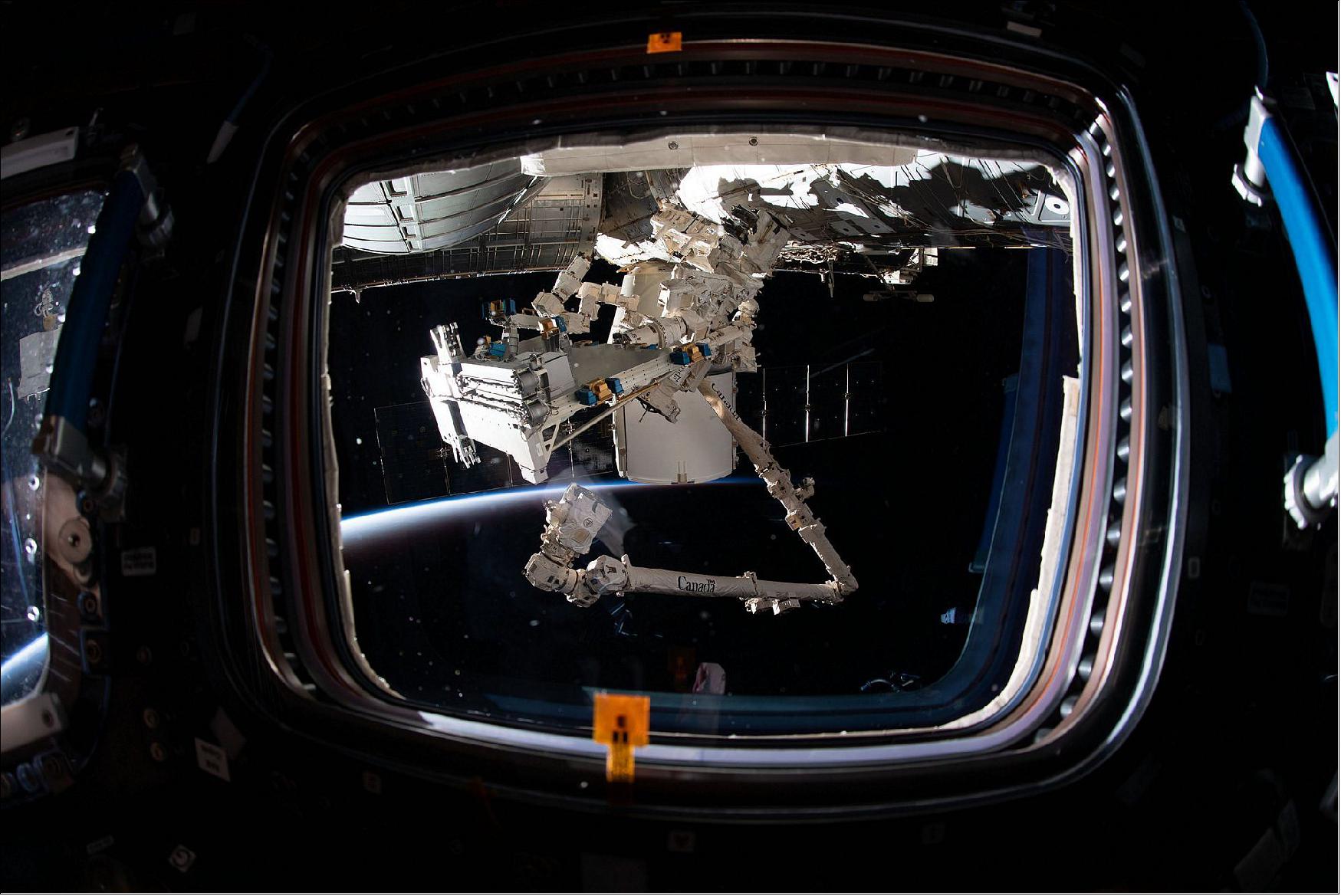
• April 7, 2020: The first European external commercial facility on the International Space Station arrived at its new home last week: the Columbus laboratory module. 22)
- Bartolomeo, named after the younger brother of Christopher Columbus, was installed by the robotic arm on the forward-facing side of the space laboratory on 2 April 2020.
- The platform, with blue hinges center-right of the photo, is at the end of the Dextre attachment that is part of Canada's 16-m robotic arm for the International Space Station. In an intricate process controlled from Earth, the robotic arm took Bartolomeo from the external trunk of the Dragon cargo vessel and moved it into position on Columbus. The 20th SpaceX Dragon mission departed from the Space Station today to splashdown in the Pacific Ocean.
- Bartolomeo is built and operated by Airbus, and hosted by ESA on the International Space Station. The facility has a clear view of Earth and the service benefits from high-speed data transfer to provide easy access to space at competitive prices.
- Previous spacewalks prepared Columbus' hull to receive the new host facility by adapting support pins to which Bartolomeo will connect. Astronauts will perform another spacewalk to install Bartolomeo in the next few months, together with a new terminal called ColKa that will upgrade the European space laboratory.
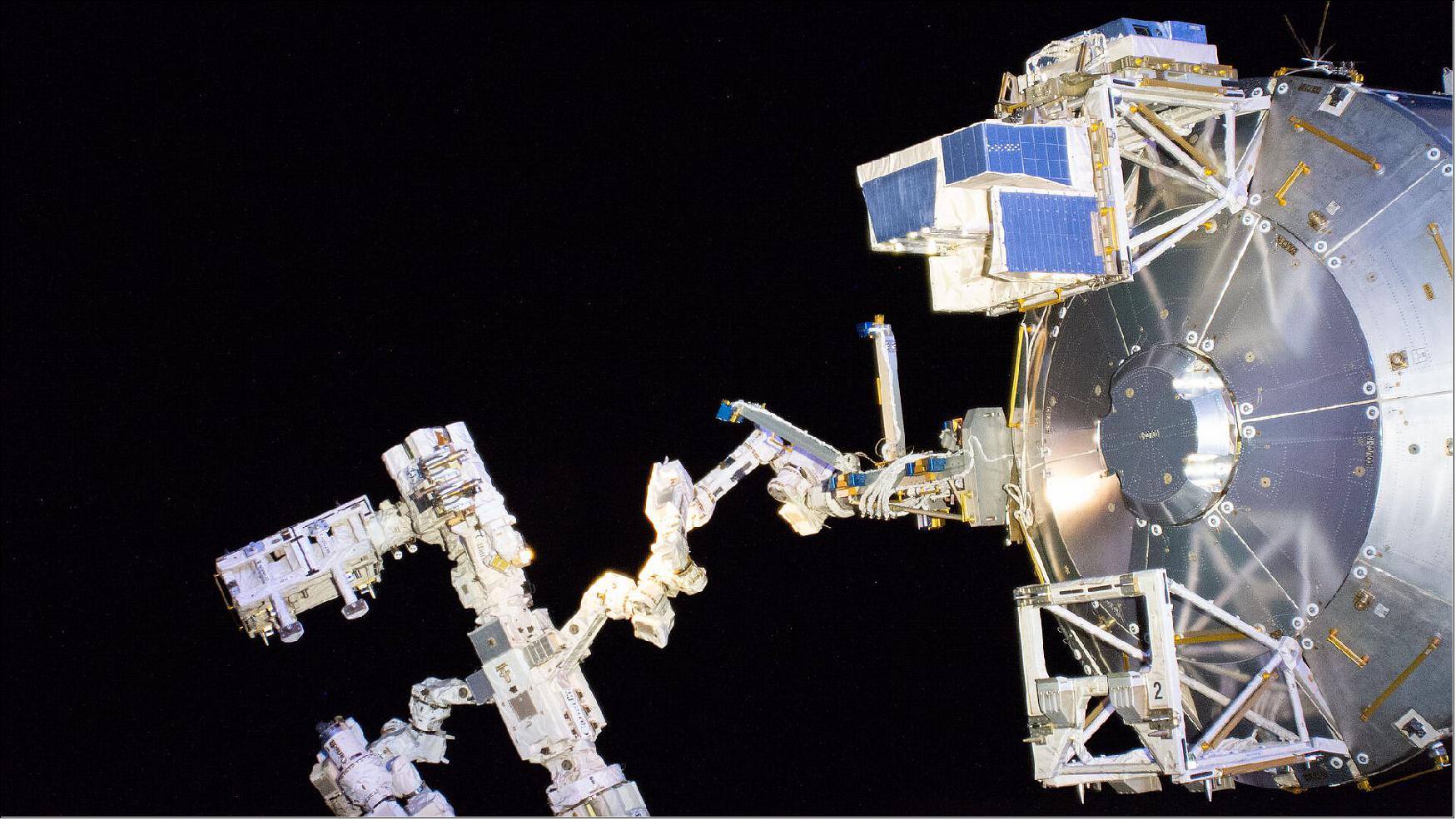
Sensor Complement
Communication with Bartolomeo Payloads
Figure 20 gives an overview of the communication architecture. For telemetry and telecommanding purposes the Bartolomeo Data Handling System (BTL-DHS) connects all payloads to the Columbus Multi-Purpose Computer Communication (MPCC) system allowing the customers to operate and control their payloads directly via Ethernet protocols and under the protection of a Virtual Private Network (VPN) between the MPCC and the Bartolomeo Control Center (BTL-CC) at Airbus (Ref. 8).
The telemetry monitoring and commanding of payloads can be done directly by each customer through an individual web console operating in the Airbus Cloud. The cloud provides state of the art security features. Different domain zones for different types of classified data including military level classifications are available. Services are deployed for public access inside the so called De-Militarized Zones (DMZ). Each DMZ is wrapped by an HTTPS-based multi-factor authentication mechanism to protect all hosted applications which are visible to the World Wide Web. On top of that, the platform provides secure multi-tenancy mechanisms by default. Every customer has his own isolated virtual environment which contains separately managed applications, e. g. the payload applications. BTL-CC has its separated additional Openshift tenant instance, which receives the telemetry of all Bartolomeo payloads.
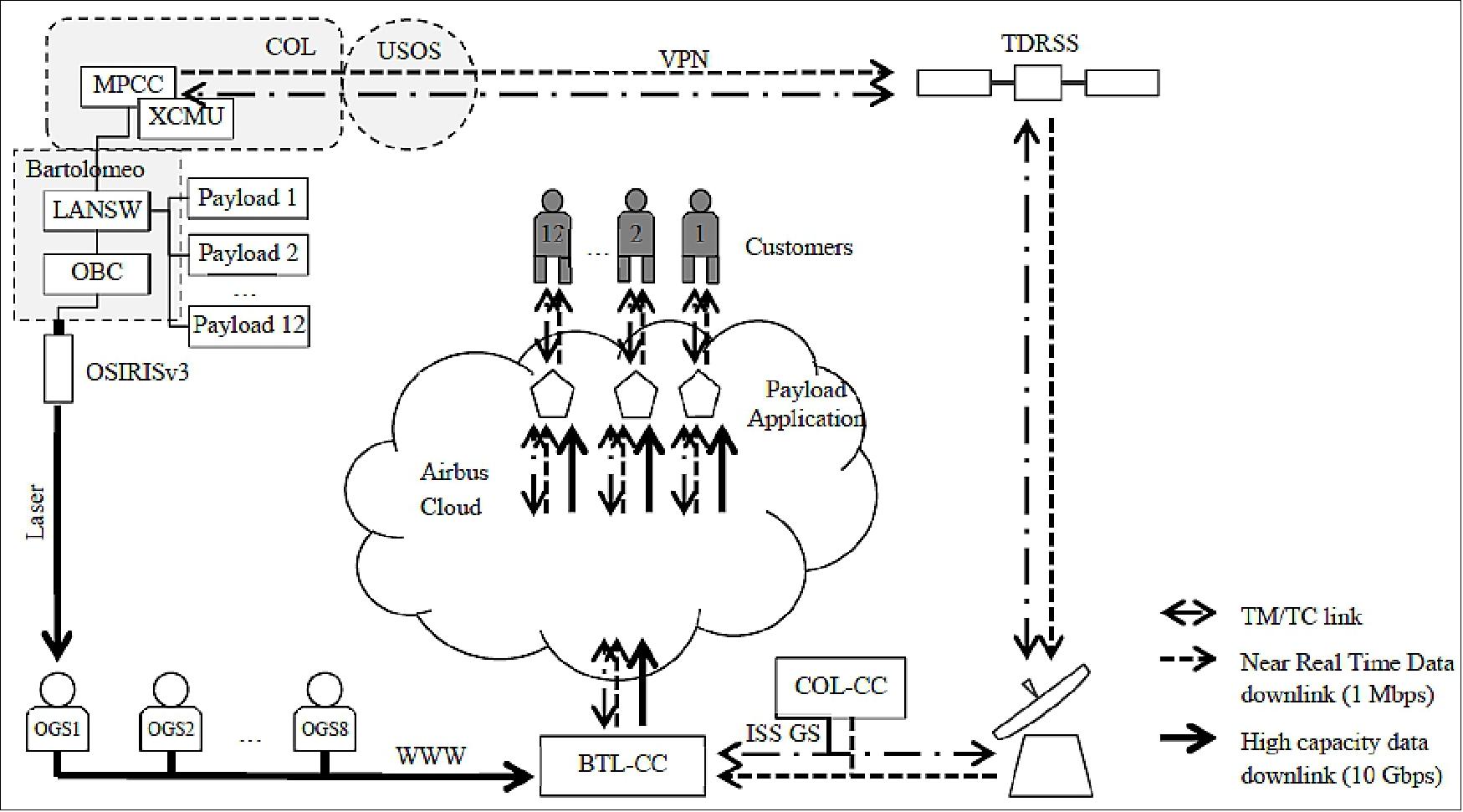
All Bartolomeo applications are hosted inside the container platform Redhat Openshift. Parts which must be visible to the public internet are hosted inside a dedicated DMZ Openshift instance. All other components are hosted inside the private Openshift instance to assure the maximum possible security. The Openshift platform provides automatic load balancing for high traffic and high performance computing scenarios. The containers healthiness and readiness will be monitored automatically by the platform. In case of unhealthy or broken services Openshift re-deploys, based on customized rules, the hosted services automatically to guarantee permanent availability and provide maximum quality of service.
The standard customer service will include one terabyte storage for each payload. Additional storage and long-term archiving solutions can be provided upon request and can be combined with in-house used big data solutions, with quasi unlimited storage capacities.
The Bartolomeo payload application provides a number of preconfigured data analytics modules (Figure 21):
- Report automation
- Trend analysis
- Planning
- Monitoring and control
- Anomaly processing efficiency
- Anomaly detection.
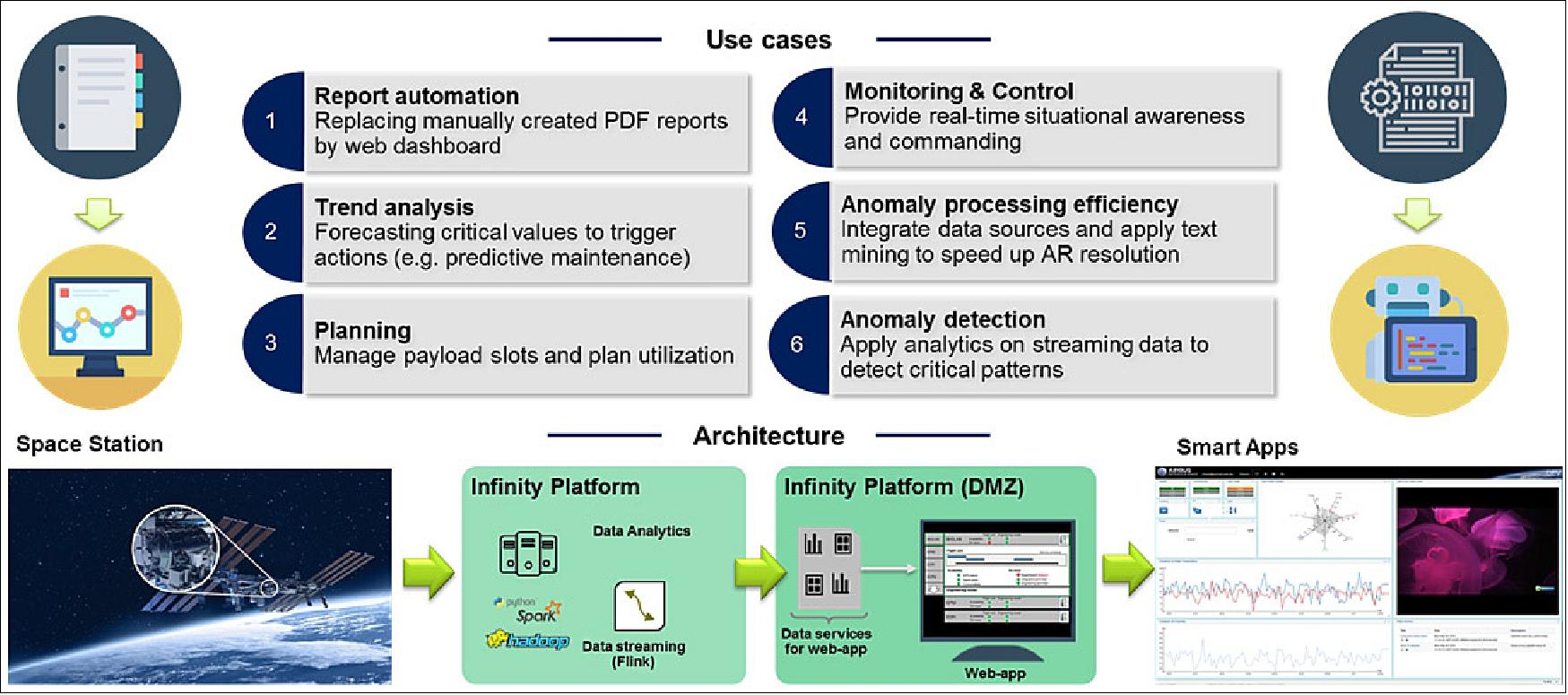
In addition to the payload-level control through the Airbus Cloud, the Columbus Control-Center (COL-CC) controls the Bartolomeo payload power switches via the Columbus External Command & Measurement Unit (XCMU). The BTL-DHS provides three independent control layers, two commanded by the COL-XCMU and one by the COL-MPCC. This design enables safety-critical operations by protecting against payload inadvertent switch-on in a two fault tolerant way during specific ISS flight phases. Payload operations are initiated by the activation of independent power switches:
• Inhibit 1: COL PDU power outlet on/off command switch to support the platform (already on when platform is operational).
• Inhibit 2: BTL PDCU power switch to the payload within the Bartolomeo PDCU controlled by BTL DHS.
• Inhibit 3: P/L power switch within the payload operated by Bartolomeo Control Center (BTL-CC) and/or COL-CC and via COL XCMU command.
All inhibits are independent from each other. Inhibit 1 is controlled by the Columbus Flight Control Team at COL-CC or the ISS crew, Inhibit 2 is activated by the BTL-CC via MPCC and BTL -DHS, and Inhibit 3 is controlled by BTL-CC or Col-CC via XCMU discrete command. As soon as the power is provided to the payload experiment the payload user takes over the control of his payload. BTL-CC and COL-CC only manage and monitor resources and assure Safety-compliant payload operations through COL XCMU telemetry monitoring and commanding.
Some payload data can be transferred via the MPCC Ethernet connection which is established within the existing ISS Ku-band based communication link. The expected bandwidth available for Bartolomeo payloads is around 0.1 Mbit/s allowing to downlink up to 1 GB per day. The Ku-band link has a very good availability with 70 - 90% availability over the orbit which gives almost real-time data connectivity for considerable amounts of time. For broadband data needs, Bartolomeo will have its own communication system (see OSIRISv3). The Bartolomeo-provided payload resources and budgets are summarized in Table 4.
Item | Single payload slot | Double payload slot |
Field of View |
| • 1 slot Zenith, Ram view |
Geometric envelope | • up to 700 x 800 x 1000 mm |
up to 1000 x 800 x 1600 mm (only |
Mass | 100 kg nominal (1) | • 250 kg nominal (1) |
Power | • 120 Vdc operational power up to 125 W, 400 W or 800 W | • 120 Vdc operational power up to400+800 W (2) |
Commanding and | • Health status signal (active driver) via XCMU | |
Basic data downlink | 0.1 Mbit/s (real time when available) | 0.2 Mbit/s (real time when available) |
Enhanced data downlink | Up to 2.5 TB / day (non- real time) | |
Robotic interface | Included in the standard payload interface | |
Return capability | Yes, if airlock compatible size | No |
Note 1: Overall payload mass budget of the platform to be taken into account
Note 2: Depending on availability
OSIRISv3 (Optical Space Infrared Downlink System version 3) Laser Communication Terminal
Next to the communication link available through the Columbus module Bartolomeo will have its own communication system to provide an independent broadband link to Earth for payload data. The communication system is the OSIRISv3 laser terminal developed by the German Aerospace Center, Institute of Communications and Navigation (DLR-IKN) and shown in Figure 22. DLR-IKN provides the laser communication device to Bartolomeo as part of the Airbus - DLR partnership for OSIRIS in-orbit testing.
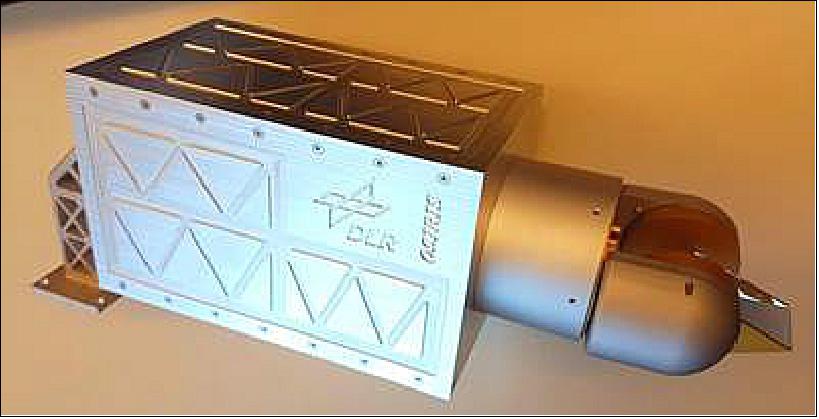
OSIRISv3 is an experimental laser communication system optimized for downlinks from small satellites. It will be demonstrated on the ISS. After a scientific phase, during which scientific channel measurements will be performed, OSIRISv3 can be used for operational data transmission as well. Furthermore, OSIRISv3 is one reference implementation of the upcoming CCSDS standard, ensuring its compatibility with world-wide optical ground station networks.
OSIRISv3 establishes a direct link to Optical Ground Stations (OGS) with a channel data rate of 10 Gbit/s.23) Link budget and availability analyses, based on cloud cover models performed by DLR-IKN estimate an expected daily throughput between 1.375 and 2.5 TB for a network of 8 Optical Ground Stations (OGS).
The laser communication terminal is accommodated on Bartolomeo on a Nadir-pointing boom enabling a good field of view independent from the Bartolomeo payload configuration. In this position, and with an additional cover to block illumination of the ISS structure, the laser may interfere only with the ISS solar arrays. With a maximum power density below 6000 W/m2 potentially being exerted, there will be no risk of damaging the ISS solar arrays. The interference between the laser beam and the arrays is avoided by the Osiris software which automatically switches off the beam based on the available ISS on-board telemetry on the solar array positions. This software safety solution enables the extension of the field of view to the areas temporarily obstructed by the arrays For ISS visiting vehicles, however, this strategy is not applicable, and a mechanical hard stop on the coarse pointing assembly is required to mechanically constrain the field of view available for laser pointing (Figure 23).
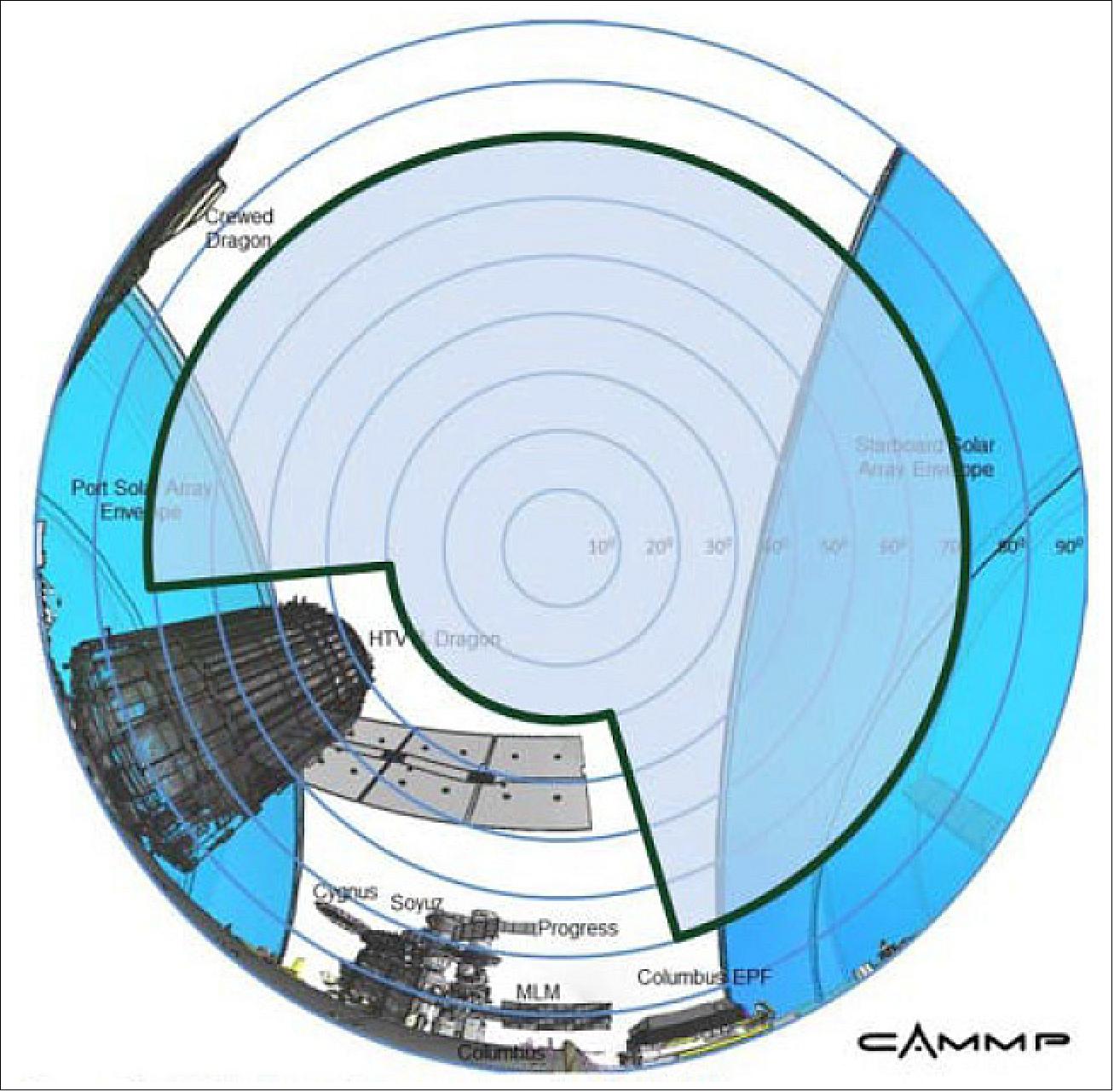
The OSIRISv3 terminal will be launched in soft-stowed configuration separately from the Bartolomeo platform. The soft-stowed launch significantly reduces the mechanical loads experienced by the payload. Thereby, a launch lock securing the coarse pointing assembly can be avoided. This launch lock would have been difficult to remove robotically on orbit. After having been launched pressurized OSIRISv3 will be installed on its accommodation boom like a standard Bartolomeo payload.
OSIRIS Laser Communication Terminal versions implemented at DLR (cooperation between DLR and Tesat Spacecom):
1) OSIRISv1 is installed on Flying Laptop (University of Stuttgart). Launched on 14 July 2017. Open loop body pointing. Data rate of 100 Mbit/s. Mass of 1.2 kg.
2) OSIRISv2 is installed on the BIROS (Berlin InfraRed Optical System) mission of DLR. Launched on 22 June 2016. Closed loop body pointing (with aid of beacon laser). Data rate of up to 1 Gbit/s. Mass of 1.65 kg.
3) OSIRISv3 ia an ISS-Bartolomeo payload, a commercial mission of Airbus DS with a launch scheduled in 2020. Active beam steering with a coarse pointing assembly. Data rate: up to 10 Gbit/s.
ArgUS Multi-Payload Frame
Bartolomeo is designed host payloads of sizes in the 100 - 450 kg range in either a "Single" or "Double" payload configuration. However, also smaller than Single payloads can be accommodated in an efficient way. The smaller payloads will share a Single slot using the ArgUS multi-payload frame with an own sub-avionics capable of monitoring and controlling the sub-payloads, their power consumption and data flows. This multi-payload frame is compatible with all Bartolomeo payload slots except of Slot 7 and Slot 8. ArgUS provides for internal ISS payload removal and replacement, transfer of the integrated payload through one of the ISS payload airlocks. ArgUS will then operate payloads in the open space environment while attached to the Bartolomeo platform. The ArgUS platform allows for various configurations with different standard sizes of payloads. An example is shown in Figure 24.
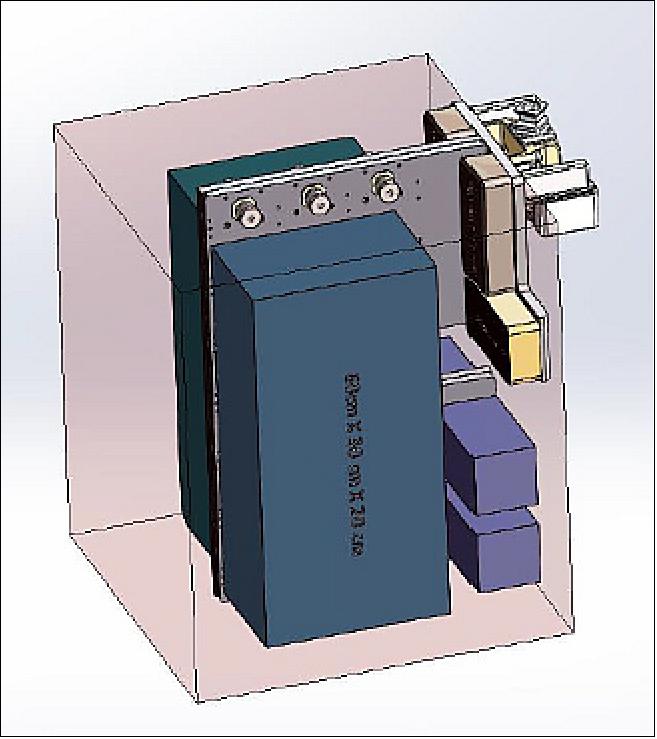
Payloads are typically oriented in the Nadir-Zenith line. The Argus plate can accommodate sideward placement for limited payload slots. Payloads with nonstandard sizes may either use the available attachment interfaces and volume on the experiment base plate or, in case of large payloads they may use the entire available volume.
ArgUS has its own avionics and power supply to enable the operations of up to 10 active payloads in parallel. ArgUS also features the OTCM / SPDM umbilical interface required to provide heater power through the ISS robotic system during installation. The ArgUS capabilities are summarized in Table 5.
Parameter | Capability |
Slot compatibility | Slot 1, 2, 3, 4, 5, 6 |
Airlock compatibility | JEM-A/L (Airlock), NRAL (NanoRacks Airlock) |
Sub-payload mass | 4 - 100 kg |
Sub-payload volume | 3U up to Single payload maximum volume |
Nominal voltage range | 28 V ± 2 V |
Nominal power | 140 W |
Maximum current | 5 A |
In summary, Bartolomeo is a competitive system, embedded in an end-to-end service. Bartolomeo contributes by achieving the scientific and economic goals defined in the strategy of the ISS program partners, responds to the demand for additional external payload hosting sites on ISS, and provides a most attractive mission solution to the commercial and institutional user community in LEO (Low Earth Orbit). The Bartolomeo payload hosting service is available on commercial terms and conditions and will significantly reduce the cost of a space mission in LEO.
References
1) Christian Steimle, Ron E. Dunklee, Bill Corley, Bartolomeo - Commercial External Payload Hosting Facility on ISS," Proceedings of the 67th IAC (International Astronautical Congress), Guadalajara, Mexico, Sept. 26-30, 2016, paper: IAC-16-B.3.4-B.6.5.1
2) "Airbus Defence and Space and the European Space Agency (ESA) launch Bartolomeo, an innovative external commercial payload platform for the ISS," Airbus DS, June 2, 2016, URL: https://airbusdefenceandspace.com/newsroom/news-and-features/airbus-defence-and-space-and-the-european-space-agency-esa-launch-bartolomeo-an-innovative-external-commercial-payload-platform-for-the-iss/
3) "Christopher Columbus' Brother's Space Journey With Airbus Defence and Space & Neumann Space," Satnews Daily, Sept. 29, 2016, URL: http://www.satnews.com/story.php?number=1169213776
4) Christiam Steimle, Uwe Pape, Ronald Dunklee,Bill Corley, "Bartolomeo - Multi-purpose Payload Hosting Facility on Columbus," November 30, 2015, URL: http://nanoracks.com/wp-content/uploads/15-Christian-Steimle-Bartolomeo-Concept-Airbus.pdf
5) Hauke Ernst, Christian Steimle, Luca Briganti, Ron E. Dunklee, "Commercial Utilization of European ISS Elements," Proceedings of the 67th IAC (International Astronautical Congress), Guadalajara, Mexico, Sept. 26-30, 2016, paper: IAC-16-B.3.4-B.6.5.5
6) "All-in-one service for the Space Station," ESA, 7 Feb. 2018, URL: http://m.esa.int/Our_Activities/Human_Spaceflight/Columbus/All-in-one_service_for_the_Space_Station
7) M. Whorton, O. Adetona, "Earth Observation from the International Space Station: The Teledyne "Multiple User System for Earth Sensing" (MUSES)," Advances in the Astronautical Sciences Guidance, Navigation and Control, Vol. 151, 2014
8) Christian Steimle, Carl Walz, Christian Fuchs, Don Pedersen, Chiara M. Lombardi, "Bartolomeo External Platform Entering Into Commercial Service," Proceedings of the 70th IAC (International Astronautical Congress), Washington DC, USA, 21-25 October 2019, paper: IAC-19.B3.3, URL: https://iafastro.directory/iac/proceedings/IAC-19/IAC-19/B3/3/manuscripts/IAC-19,B3,3,12,x52212.pdf
9) Christian Steimle, Bill Corley, "New Bartolomeo External Platform on its Pathway to Space," 8th Annual International Space Station Research and Development Conference, July 29- August 1, 2019, Atlanta, GA, USA, URL: http://amz.xcdsystem.com/4F14E44B-BC41-E69B-DFAF5A1B1627A0EA_abstract_File14318/PDFUpload_36_0724024609.pdf
10) "Cleared for commercialization – Bartolomeo external platform to expand usage of the ISS," DLR, 4 March 2020, URL: https://www.dlr.de/content/en/articles/news/2020/01/20200304_bartolomeo-external-platform-to-expand-usage-of-the-iss.html
11) "Bartolomeo heading for space to join Columbus," ESA / Science & Exploration / Human and Robotic Exploration, 5 March 2020, URL: http://www.esa.int/Science_Exploration/Human_and_Robotic_Exploration/Bartolomeo_heading_for_space_to_join_Columbus
12) Linda Herridge, "Bartolomeo Platform Prepared for Delivery to International Space Station," NASA, 7 February 2020, URL: https://www.nasa.gov/image-feature/bartolomeo-platform-prepared-for-delivery-to-international-space-station
13) "European boost to the all-in-one Bartolomeo service for the Space Station," ESA / Science & Exploration / Human and Robotic Exploration, 23 October 2019, URL: http://www.esa.int/Science_Exploration/Human_and_Robotic_Exploration/European_boost_to_the_all-in-one_Bartolomeo_service_for_the_Space_Station
14) "Accessing Space with the ISS Bartolomeo Platform UNOOSA Call for Interest," UNOOSA, 6 December 2018, URL: http://www.unoosa.org/documents/pdf/psa/hsti/Bartolomeo/Bartolomeo_CFI.pdf
15) "First high capacity space-to-ground laser communications system for the European external ISS platform," Geospatial World, 26 March 2018, URL: https://www.geospatialworld.net/news/first-high-capacity-communications-system-european-iss-platform/
16) "Bartolomeo Platform Partnership Agreement Signed Between ESA and Airbus," Satnews, Daily, 7 Feb. 2018, URL: http://www.satnews.com/story.php?number=588075544#
17) Stephen Clark, "Late-night launch of SpaceX cargo ship marks end of an era" Spaceflight Now, 7 March 2020, URL: https://spaceflightnow.com/2020/03/07/late-night-launch-of-spacex-cargo-ship-marks-end-of-an-era/
18) "Airbus Defence and Space and Australia's Neumann Space Sign First Payload Agreement for the New Bartolomeo Platform on ISS," Airbus DS News, Sept. 29, 2016, URL: https://airbusdefenceandspace.com/newsroom/news-and-features/airbus-defence-and-space-and-australias-neumann-space-sign-first-payload-agreement-for-the-new-bartolomeo-platform-on-iss/
19) "Space vs. materials – orbital testing outside Space Station," ESA Enabling & Support, 25 March 2021, URL: https://www.esa.int/Enabling_Support/Space_Engineering_Technology/Space_vs._materials_orbital_testing_outside_Space_Station
20) "Orbital space ageing tests offered for space age materials," ESA / Enabling & Support / Space Engineering & Technology, 04 June 2020, URL: http://www.esa.int/Enabling_Support/Space_Engineering_Technology/Orbital_space_ageing_tests_offered_for_space_age_materials
21) "Xenesis to space-test optical communication terminal aboard Airbus facility on ISS," Airbus, 5 May 2020, URL: https://web.archive.org/web/20210917203522/https://www.airbus.com/newsroom/press-releases/en/2020/05/airbus-and-xenesis-sign-payload-contract-for-new-bartolomeo-platform-on-the-international-space-station.html
22) "Bartolomeo connected to Columbus," ESA Science & Exploration, 7 April 2020, URL: http://www.esa.int/ESA_Multimedia/Images/2020/04/Bartolomeo_connected_to_Columbus
23) Christian Fuchs, Christopher Schmidt, "Update on DLR's OSIRIS program," International Conference on Space Optics—ICSO 2018, Chania, Greece, 9–12 October 2018, Edited by Zoran Sodnik, Nikos Karafolas, and Bruno Cugny, URL: https://www.spiedigitallibrary.org/conference-proceedings-of-spie/11180/2535937/Update-on-DLRs-OSIRIS-program/10.1117/12.2535937.full
24) Garcia, Mark. “Partners Extend International Space Station for Benefit of Humanity – Space Station.” NASA Blogs, 27 April 2023, https://blogs.nasa.gov/spacestation/2023/04/27/partners-extend-international-space-station-for-benefit-of-humanity/
The information compiled and edited in this article was provided by Herbert J. Kramer from his documentation of: "Observation of the Earth and Its Environment: Survey of Missions and Sensors" (Springer Verlag) as well as many other sources after the publication of the 4th edition in 2002. Comments and corrections to this article are always welcome for further updates (eoportal@symbios.space).
Platform System Launch Mission Status OSIRISv3 References Back to top